Join Pilot Waitlist

Home » Blog » IEP Goals and Objectives » Effective IEP Goals for Developing Problem-Solving Skills


Effective IEP Goals for Developing Problem-Solving Skills

Special education plays a crucial role in helping students develop essential life skills. One such skill is problem-solving, which has a significant impact on students’ learning, social interactions, and overall wellbeing. In this blog post, we will explore problem-solving skills and how to create effective IEP goals for high school students.
What Are Problem-Solving Skills
Problem-solving skills involve a series of steps students can take to identify, analyze, and resolve issues they encounter. These skills are vital for students’ learning as they help them overcome obstacles and make informed decisions. Additionally, problem-solving skills contribute to students’ social interactions and wellbeing by enabling them to navigate various social situations and maintain healthy relationships.
The Role of Specialists
Various specialists can support the development of problem-solving skills in students:
- Speech-Language Pathologists: They can help students improve their communication abilities, which are crucial for expressing and understanding problems.
- Social Workers: They can provide guidance and resources to help students address social and emotional challenges that may hinder problem-solving.
- Psychologists: They can assist in identifying any underlying cognitive or emotional barriers that may affect students’ problem-solving abilities.
- School Counselors: They can offer support in developing students’ decision-making and coping skills, which are essential components of problem-solving.
IEP Goals for Problem-Solving Skills
Here are some SMART IEP goals to help students develop problem-solving skills:
Goal 1: The student will identify and classify problems as big or small in 90% of situations within six months.
Strategy: Teach students the criteria for differentiating between big and small problems and provide opportunities for practice.
Activity: Role-play scenarios involving various problems and have students classify them as big or small.
Goal 2: The student will generate at least three possible solutions to a given problem in 80% of situations within six months.
Strategy: Teach students brainstorming techniques and encourage them to think creatively when faced with problems.
Activity: Provide problem-solving worksheets that require students to list multiple potential solutions.
Goal 3: The student will evaluate and select the best solution to a given problem in 80% of situations within six months.
Strategy: Teach students how to weigh the pros and cons of each solution and consider potential outcomes.
Activity: Engage students in group discussions where they analyze potential solutions and collectively decide on the best approach.
Implementing and Measuring Progress
To implement these IEP goals, consistently provide students with opportunities to practice problem-solving skills in various settings. Monitor their progress using data collection tools, such as checklists and rating scales, to track their improvement over time. Regularly review and adjust goals as needed, based on the students’ progress and needs.
Developing problem-solving skills is crucial for high school students’ success in learning, social interactions, and overall wellbeing. By setting effective IEP goals and collaborating with specialists, educators can support students in becoming confident problem solvers. We encourage you to apply these IEP goals in your practice and invite you to explore more resources at Everyday Speech Sample Materials .

Related Blog Posts:
Effective iep goals for improving students’ point of view skills.
Introduction In special education, it is essential to address various skills that contribute to the overall development of students. One such significant skill is understanding others' perspectives, which plays a crucial role in fostering healthy social interactions...
Effective IEP Goals for PreK Students: Developing the Target Skill
In special education, it is crucial to identify and address target skills that can significantly impact a student's learning, social interactions, and overall wellbeing. One such essential skill is controlling strong emotions, which enables students to make better...
Effective IEP Goals for Improved Tone of Voice in Middle School Students
Introduction In special education, understanding and addressing the nuances of communication skills, such as tone of voice, is crucial for students' social and emotional development. This blog post will focus on the target skill of using a non-condescending tone of...

FREE MATERIALS
Better doesn’t have to be harder, social skills lessons students actually enjoy.
Be the best educator you can be with no extra prep time needed. Sign up to get access to free samples from the best Social Skills and Social-Emotional educational platform.
Get Started Instantly for Free
Complete guided therapy.
The subscription associated with this email has been cancelled and is no longer active. To reactivate your subscription, please log in.
If you would like to make changes to your account, please log in using the button below and navigate to the settings page. If you’ve forgotten your password, you can reset it using the button below.
Unfortunately it looks like we’re not able to create your subscription at this time. Please contact support to have the issue resolved. We apologize for the inconvenience. Error: Web signup - customer email already exists
Welcome back! The subscription associated with this email was previously cancelled, but don’t fret! We make it easy to reactivate your subscription and pick up right where you left off. Note that subscription reactivations aren't eligible for free trials, but your purchase is protected by a 30 day money back guarantee. Let us know anytime within 30 days if you aren’t satisfied and we'll send you a full refund, no questions asked. Please press ‘Continue’ to enter your payment details and reactivate your subscription
Notice About Our SEL Curriculum
Our SEL Curriculum is currently in a soft product launch stage and is only available by Site License. A Site License is currently defined as a school-building minimum or a minimum cost of $3,000 for the first year of use. Individual SEL Curriculum licenses are not currently available based on the current version of this product.
By clicking continue below, you understand that access to our SEL curriculum is currently limited to the terms above.
- Grades 6-12
- School Leaders
NEW: Classroom Clean-Up/Set-Up Email Course! 🧽
Free IEP Goal Bank With 110+ Goals and Printable Tracking Sheets
All the goals you need, when you need them.
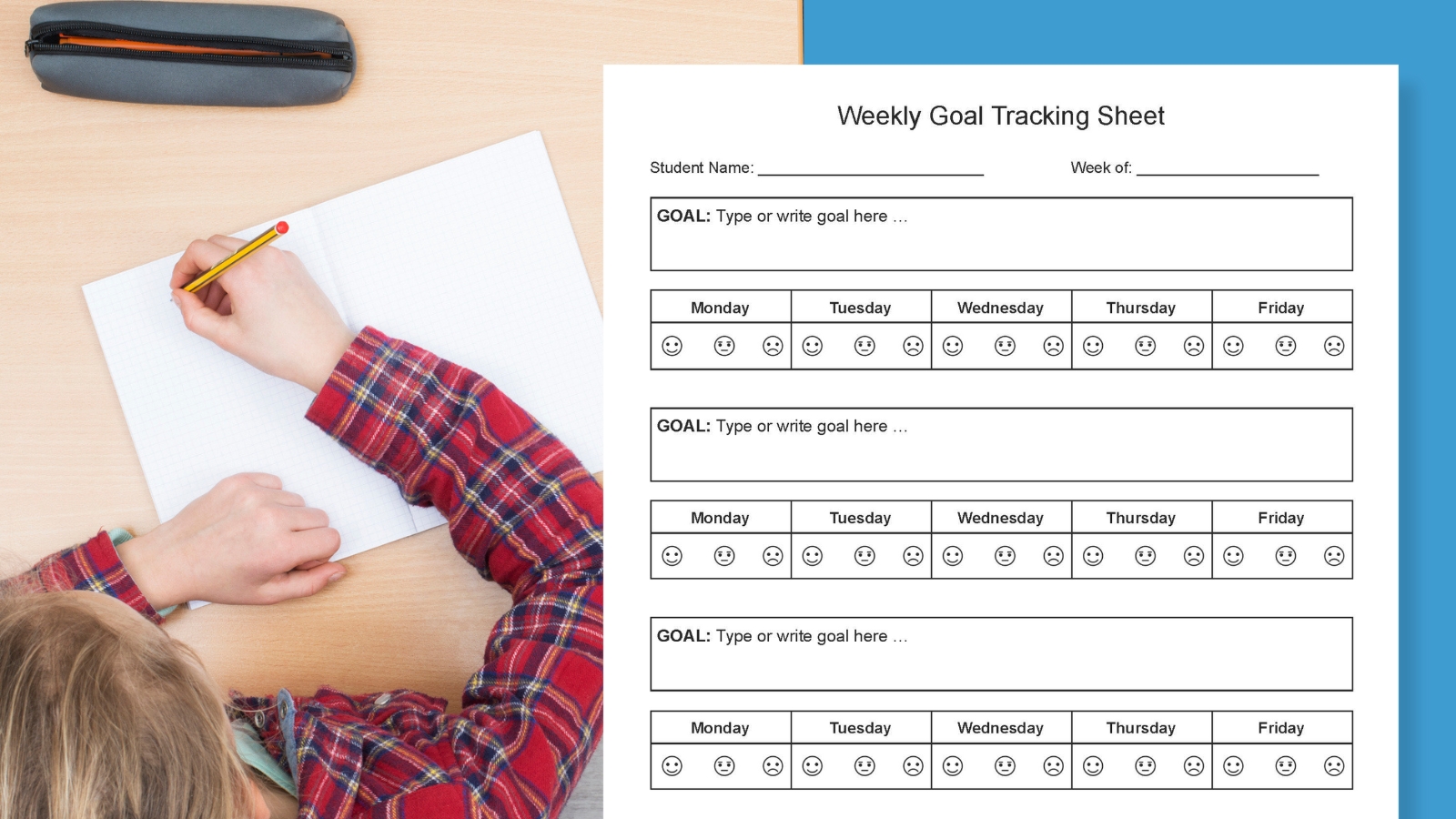
There are as many IEP goals as there are students. But the longer you teach special education, the more you’ll find yourself searching for just the right reading comprehension goal for a student with a learning disability or a behavior goal for a kid who has ADHD. That’s where an IEP goal bank, also known as a goal database, comes in.
Below you’ll find a list of over 100 IEP goals covering a variety of focus areas. Plus be sure to fill out the form on this page to get access to a free, editable Google Doc version of the goal bank along with a bundle of free editable goal-tracking sheets. The bundle includes daily and weekly goal-tracking sheets, as well as trial tracking and progress tracking sheets for data collection.
IEP Goals 101
- Reading Comprehension Goal Bank
- Math Goal Bank
- Writing Goal Bank
- Behavior Goal Bank
- Social Skills Goal Bank
- Social-Emotional Goal Bank
- Executive Functioning Goal Bank
- Self-Advocacy Goal Bank
IEP goals should be specific enough to be implemented by anyone who reads them. They should address aspects of the general curriculum but at the student’s functional level. And the goals should be actionable and measurable.
The goals should also include the accuracy and number of trials that the student needs to complete to show mastery. The accuracy and number of trials will depend on the student’s ability, strengths, and skills. (Typical accuracy and trials are 80% 4-out-of-5 trials.)
Finally, the goals should include the level of support the student needs. Should they be demonstrating the skill independently, or do they need a few prompts or maximum support? Build that into the goal too.
So, a finished goal might be: When given a pile of coins (all one type), Jaime will count the coins and find the total with no more than two prompts with 70% accuracy in 3 out of 5 trials.
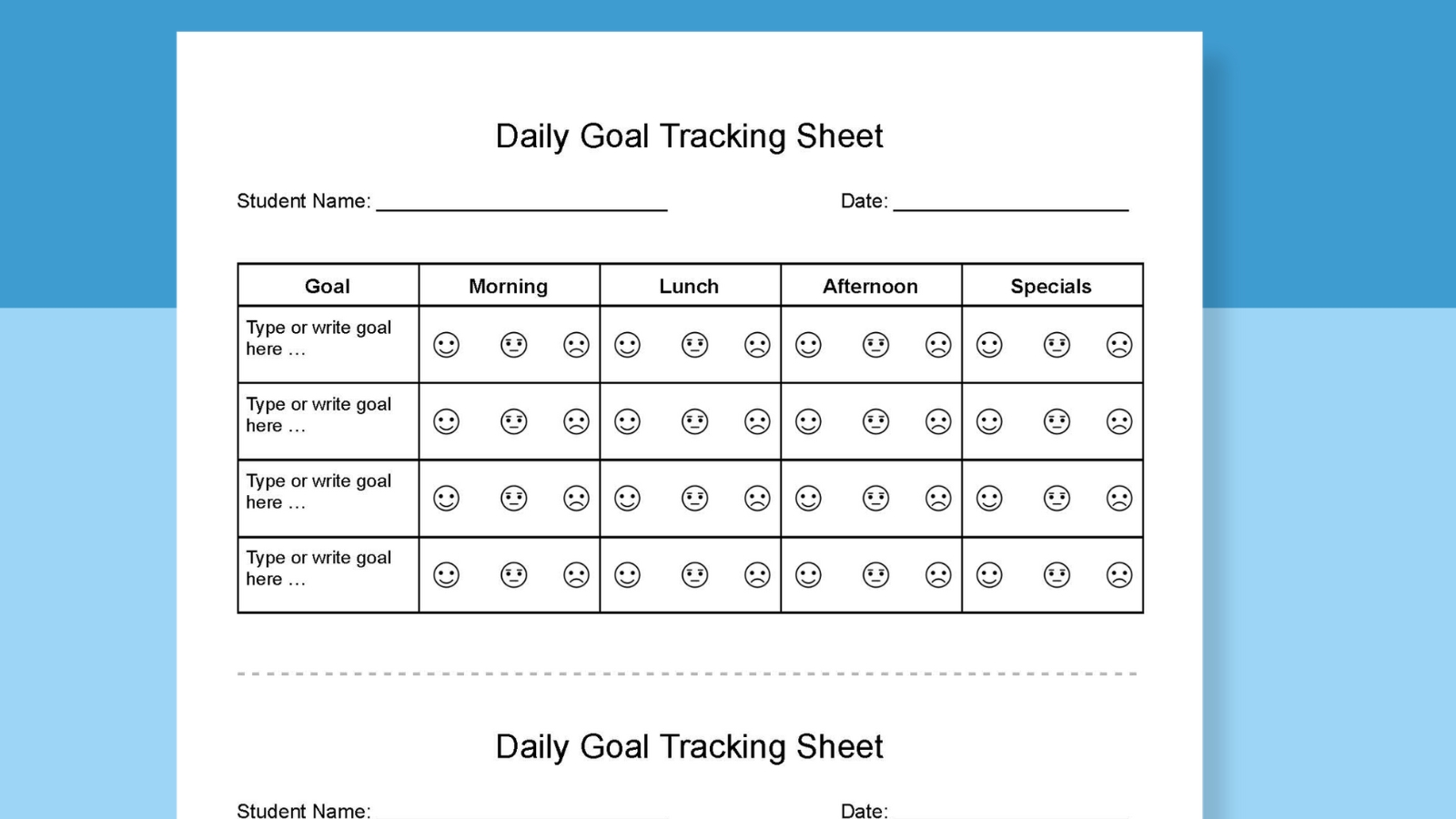
IEP Goals for Your Database
A lot of thought goes into each IEP goal, so here are more than 100 goals that every special education teacher should have in their bank.
Reading Comprehension IEP Goal Bank
Reading comprehension is a skill that many students struggle with it. Choose a goal that helps students reach the next level of reading comprehension so they can understand and enjoy what they read.
- When given a story at their reading level, [STUDENT] will use a storyboard or story map to outline the story’s main elements.
- When given a nonfiction text at their reading level, [STUDENT] will select and use the appropriate graphic organizer to identify key information.
- When given a paragraph at their reading level, [STUDENT] will apply the RAP strategy ( R eading a single paragraph, A sking oneself to define the main idea and supporting details, P utting the information into the reader’s language).

- When given a passage at their reading level, [STUDENT] will use an outline strategy to summarize the content or retell the story.
- When given a text at their reading level, [STUDENT] will read and demonstrate literal knowledge by answering five literal questions.
- [STUDENT] will demonstrate understanding of text using total communication (AAC devices, PECS, verbalization, sign language) to answer five literal questions about the text.
- When presented with a passage at their reading level, [STUDENT] will use context clues to identify the meaning of unknown words.
- When given a passage at their instructional level, [STUDENT] will make a prediction and read to confirm or adjust their prediction with information from the text.
- When given a text at their reading level, [STUDENT] will identify the main idea and two supporting details.

- Given a sentence, [STUDENT] will combine background knowledge with information from the text to infer the author’s meaning.
- Given a passage at their reading level, [STUDENT] will answer five inferential questions.
- After reading a passage with visual supports (e.g., highlighting), [STUDENT] will answer literal questions with minimal assistance.
- After reading a passage at their reading level, [STUDENT] will identify the author’s purpose for writing.
- Given a list of author’s purposes and a text, [STUDENT] will select the correct author’s purpose for writing.
Math IEP Goal Bank
Students may be working on numeracy or word problems. Whatever their focus, choose a math goal that helps them progress.
- [STUDENT] will identify a one- or two-digit number (verbally, pointing, written).
- [STUDENT] will rote-count from 1 to 25 (or higher).
- [STUDENT] will skip-count by 2, 3, 5, 10 to 50 (verbal or written).
![independent problem solving iep goal When given up to 10 objects, [STUDENT] will count and state how many objects there are (verbally, pointing).](https://www.weareteachers.com/wp-content/uploads/3-44.jpg)
- Given 10 addition problems, [STUDENT] will independently add single-digit numbers with (or without) regrouping.
- [STUDENT] will independently subtract a single-digit number from a double-digit number with (or without) regrouping.
- Given 10 subtraction problems, [STUDENT] will independently subtract double-digit numbers from double-digit numbers with (or without) regrouping.
- [STUDENT] will independently tell time to the half hour (or quarter hour, etc.) on an analog clock (verbal or written).
- [STUDENT] will independently identify the next dollar amount when given a price, determine how much is needed to make a purchase, and count out the necessary amount using school money.
- Given a quarter, dime, nickel, and penny, [STUDENT] will identify the coin and value.
- Given a random amount of coins (all one type or mixed), [STUDENT] will independently count the coins.

- When given two-digit (or three- or four-digit) numbers, [STUDENT] will round to the nearest tens (or hundreds or thousands).
- Given two numbers (pictures, groups of items), [STUDENT] will determine which number is greater than/less than/equal to by selecting or drawing the appropriate symbol.
- Given data and a graph (bar, pie), [STUDENT] will complete the graph to display the data.
- Given a graph (bar, pie, line), [STUDENT] will answer three questions about the data.
- [STUDENT] will identify the numerator and denominator in a fraction.
- When given a picture of a shape divided into parts, [STUDENT] will color the correct number of sections to represent the fraction given.

- [STUDENT] will solve one-step word problems using addition and subtraction (or multiplication and division).
- [STUDENT] will independently solve 15 multiplication facts (up to 9).
- Given a fact-fluency tracker, [STUDENT] will track mastery of multiplication facts up to 12.
- Given a problem-solving checklist, [STUDENT] will use the checklist to solve a one-step or two-step word problem.
Writing IEP Goal Bank
Here are writing IEP goals for organization, fluency, and editing.
- Given a topic, [STUDENT] will write a sentence that accurately addresses the topic.
- Given a word bank, [STUDENT] will select the appropriate words to complete a sentence or paragraph about a topic.
- [STUDENT] will use a keyword outline to write a paragraph with at least [number of] sentences, including an introduction/topic sentence and conclusion sentence.
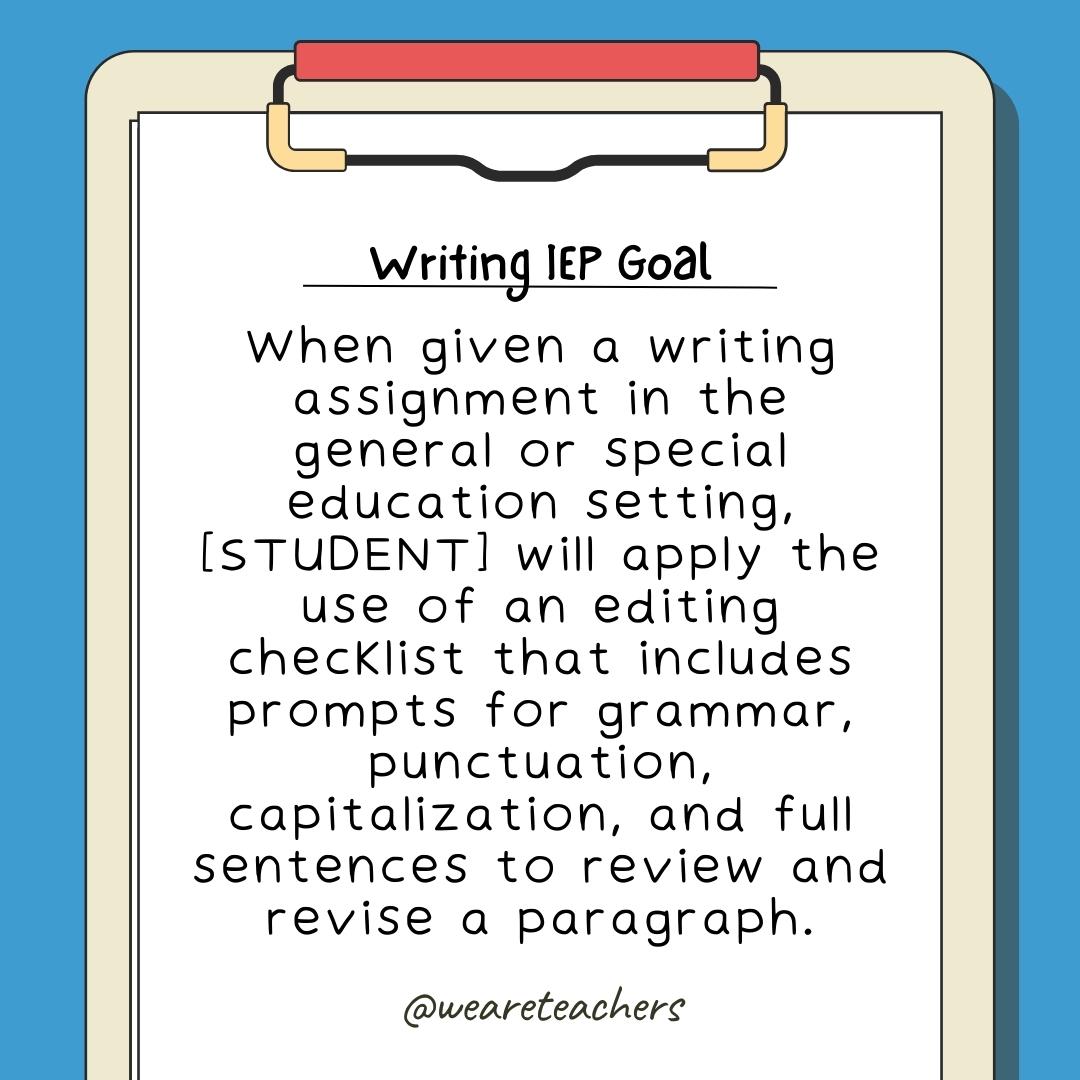
- [STUDENT] will dictate a response to a question and use talk-to-text to communicate at least three sentences about a topic.
- [STUDENT] will write a three-paragraph essay about a topic that includes a clear introductory sentence, main idea, supporting details, and conclusion.
- [STUDENT] will select and use the appropriate graphic organizers to organize ideas in response to a writing topic.
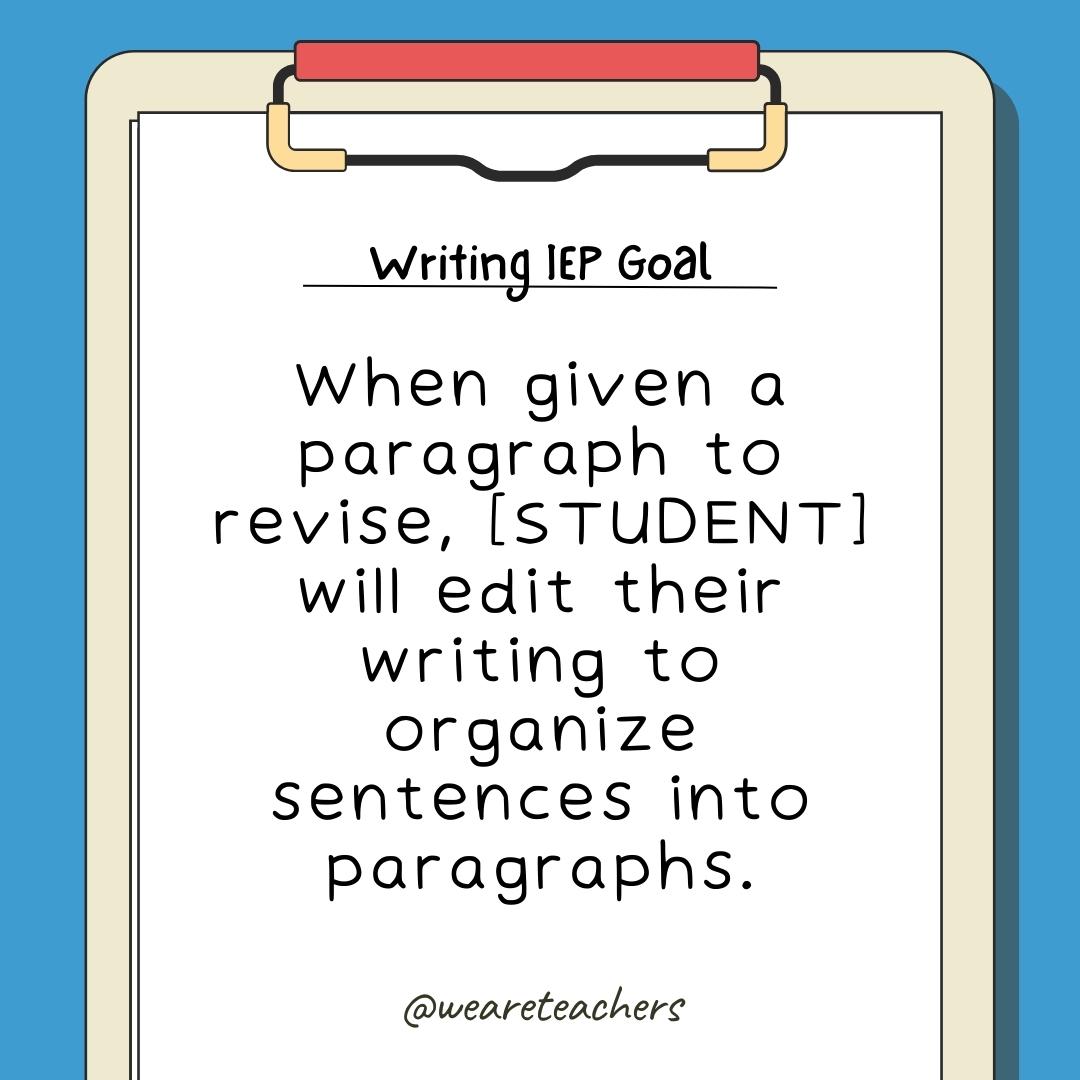
- When given a paragraph to revise, [STUDENT] will add transitional words and phrases to connect ideas in sentences (or paragraphs).
- When given a prompt, [STUDENT] will maintain writing for [amount of time] as measured by observation and student writing output.
Behavior IEP Goal Bank
Everything we see in school is behavior, from working to engaging in class to maintaining self-control and managing emotions. If a student has an IEP for ADHD, an emotional disability, autism, or other categories, they may be working on behavior goals to improve their ability to succeed in school.
- Given a self-monitoring checklist, [STUDENT] will demonstrate self-regulation during [# of sessions] across [# of months].
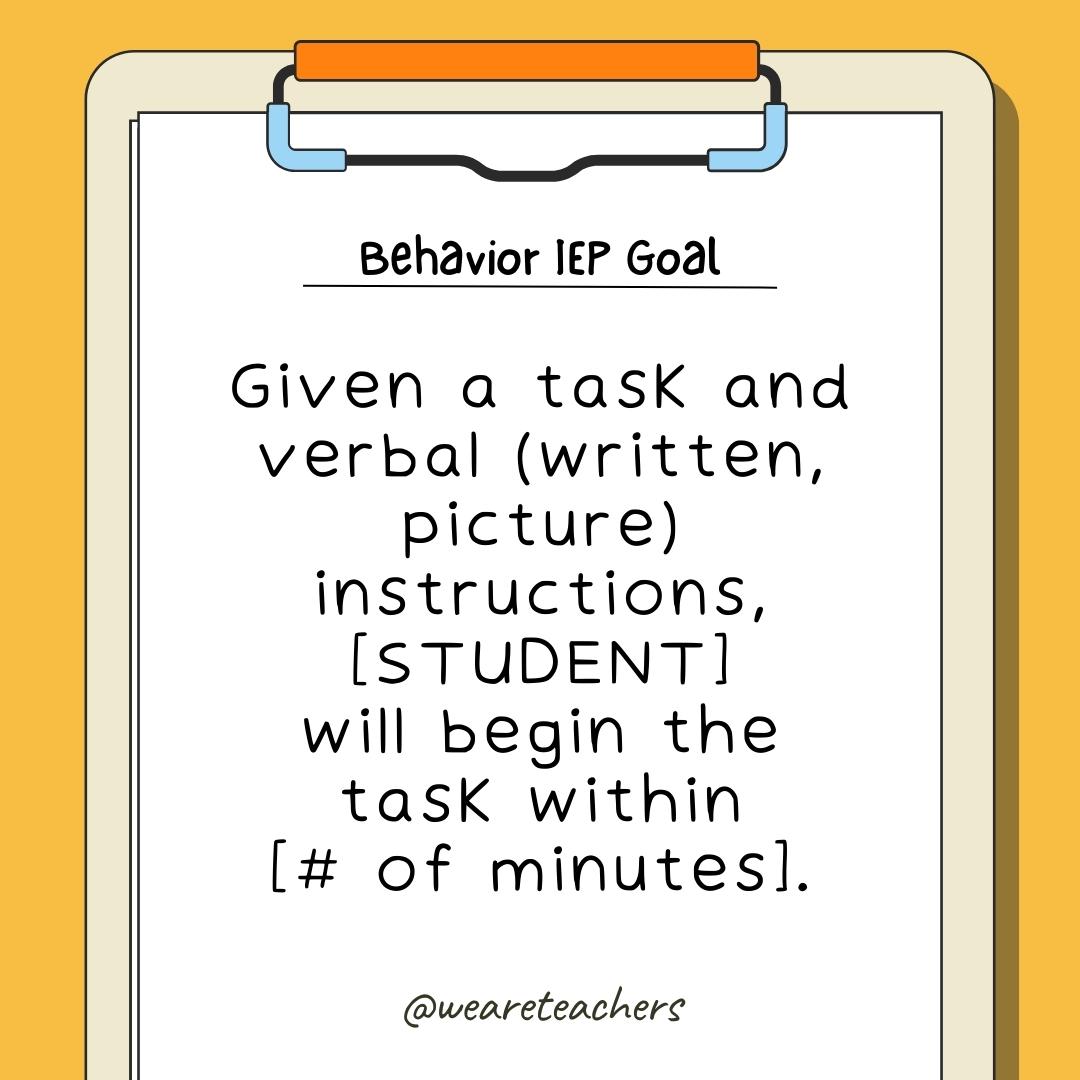
- Given a token board, [STUDENT] will follow class rules to earn [# of tokens] for each 30-minute period in special and general education settings.
- Given a self-regulation strategy (e.g., zones of regulation), [STUDENT] will identify when they are moving from green to red, and apply a self-regulation strategy to maintain their self-regulation.
- Given support and a visual model, [STUDENT] will implement an organizational system for their locker/desk/backpack/binder.
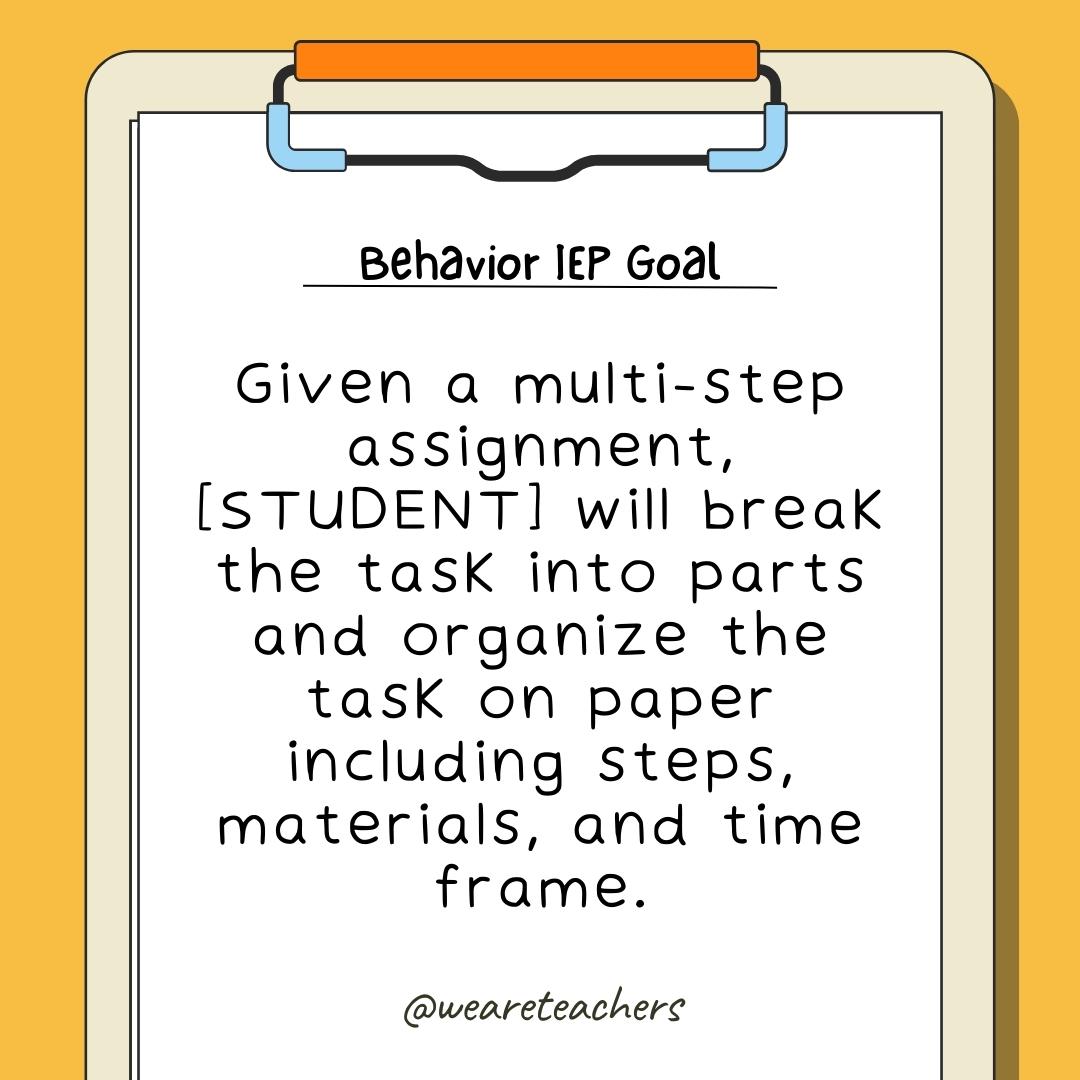
- Given scripts and reminders, [STUDENT] will manage frustration and disruptions to their routine during classroom activities.
- Given a social story, [STUDENT] will be able to adjust to new routines and procedures in the classroom.
- By the end of the IEP, [STUDENT] will manage conflicts, independent of teacher support, 4 out of 5 occurrences over a ___ time period.
- Given a work assignment, [STUDENT] will initiate work tasks as measured by observation and work completion.
- Given a work assignment, [STUDENT] will complete work tasks as measured by observation and work completion.
- Given a token board and visual or rules, [STUDENT] will follow rules and earn tokens throughout the total school environment.
Social Skills IEP Goal Bank
Social skills may not seem academic, but how students engage with others can be an important outcome for students who have deficits in this area. Here are goals that can support their progression in forming relationships with peers and adults.
- During unstructured class time, [STUDENT] will engage in respectful conversation with peers (maintain personal space, use respectful voice).
- During unstructured class time or play time (e.g., recess), [STUDENT] will engage with peers (participate, share, follow rules, take turns) for > 10 minutes with minimal adult prompting.
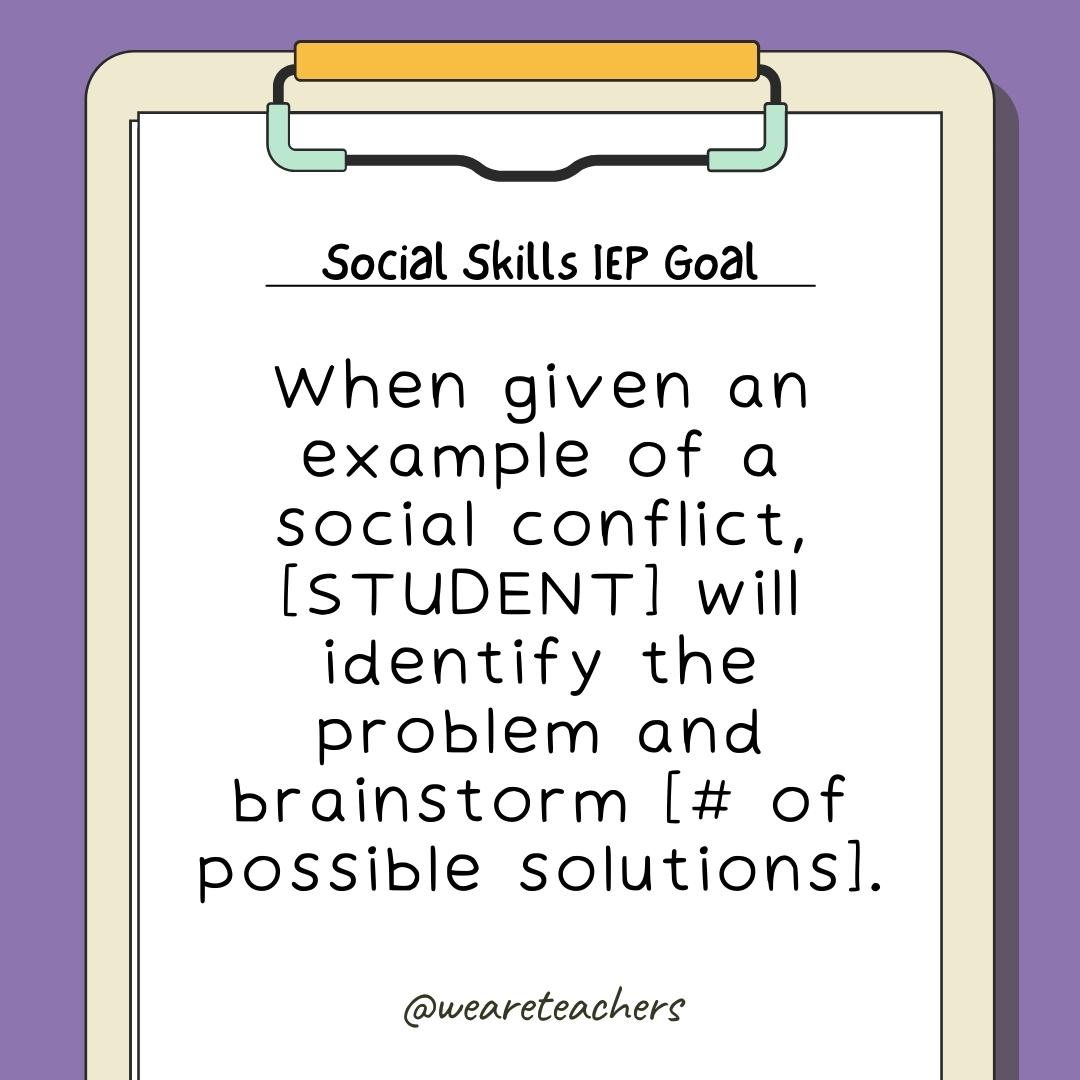
- During a preferred activity, [STUDENT] will invite a peer to join in during recess.
- During a preferred activity, [STUDENT] will engage in appropriate conversation (ask appropriate questions, respond to questions, take turns) for > five turns.
- When frustrated or involved in a conflict, [STUDENT] will resolve the conflict without aggression but will apply a problem-solving strategy (walk away, tell a teacher).
- [STUDENT] will demonstrate five back-and-forth exchanges with peers during structured play activities.
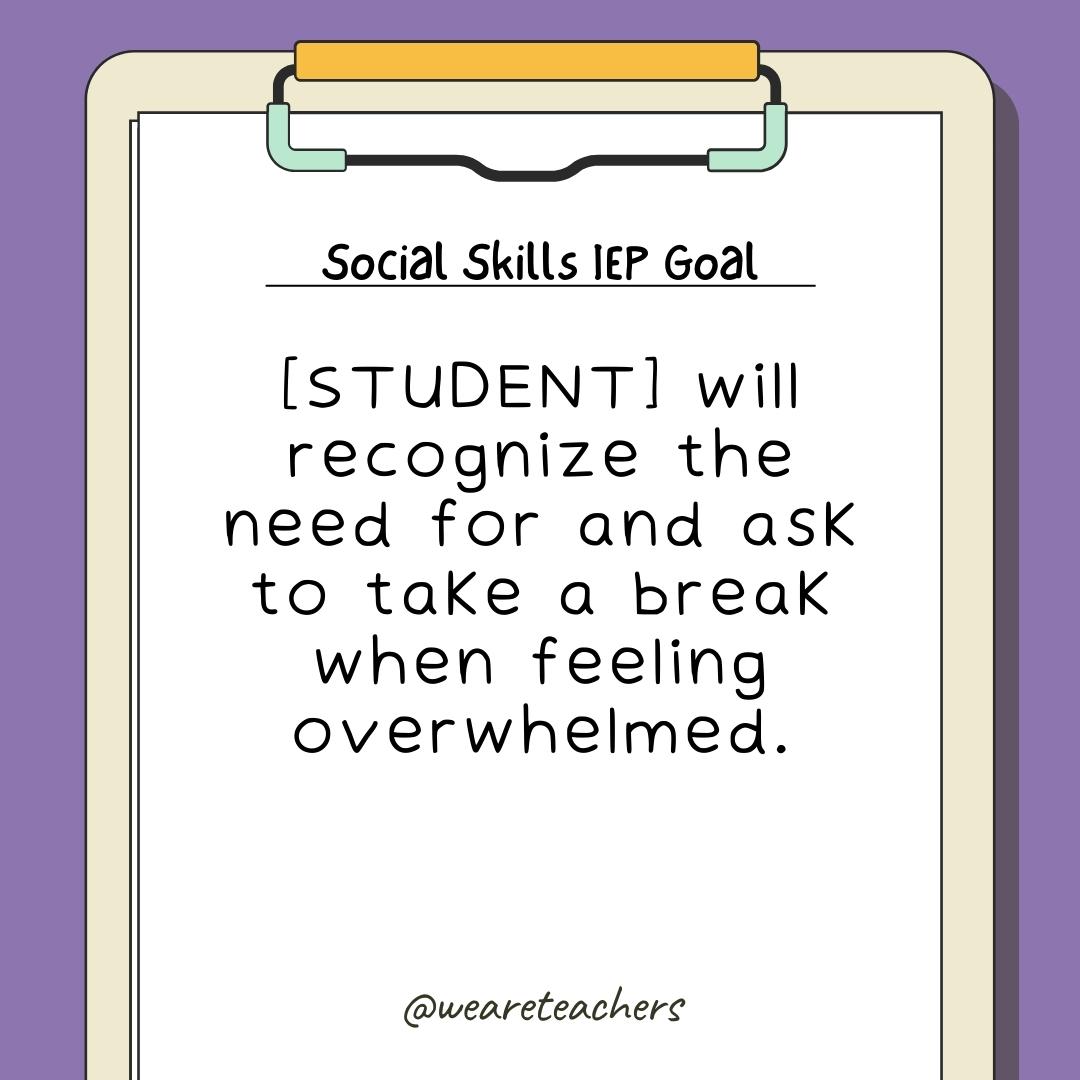
- [STUDENT] will engage in appropriate turn-taking with peers in classroom discussion.
- [STUDENT] will decrease inappropriate verbal comments to once per day (or week) or less as measured by teacher observation and behavior checklist.
- Given a pre-activity checklist, [STUDENT] will identify one peer they would like to engage with and how they are going to engage (e.g., ask a question, invite to play).
Social-Emotional Skills IEP Goal Bank
Identifying and managing feelings is another important school outcome for students who have deficits in this area. Here are goals that help students advance in social-emotional skills.
- [STUDENT] will work cooperatively with peers in small-group settings (e.g., share materials, engage in conversation, accept others’ ideas).
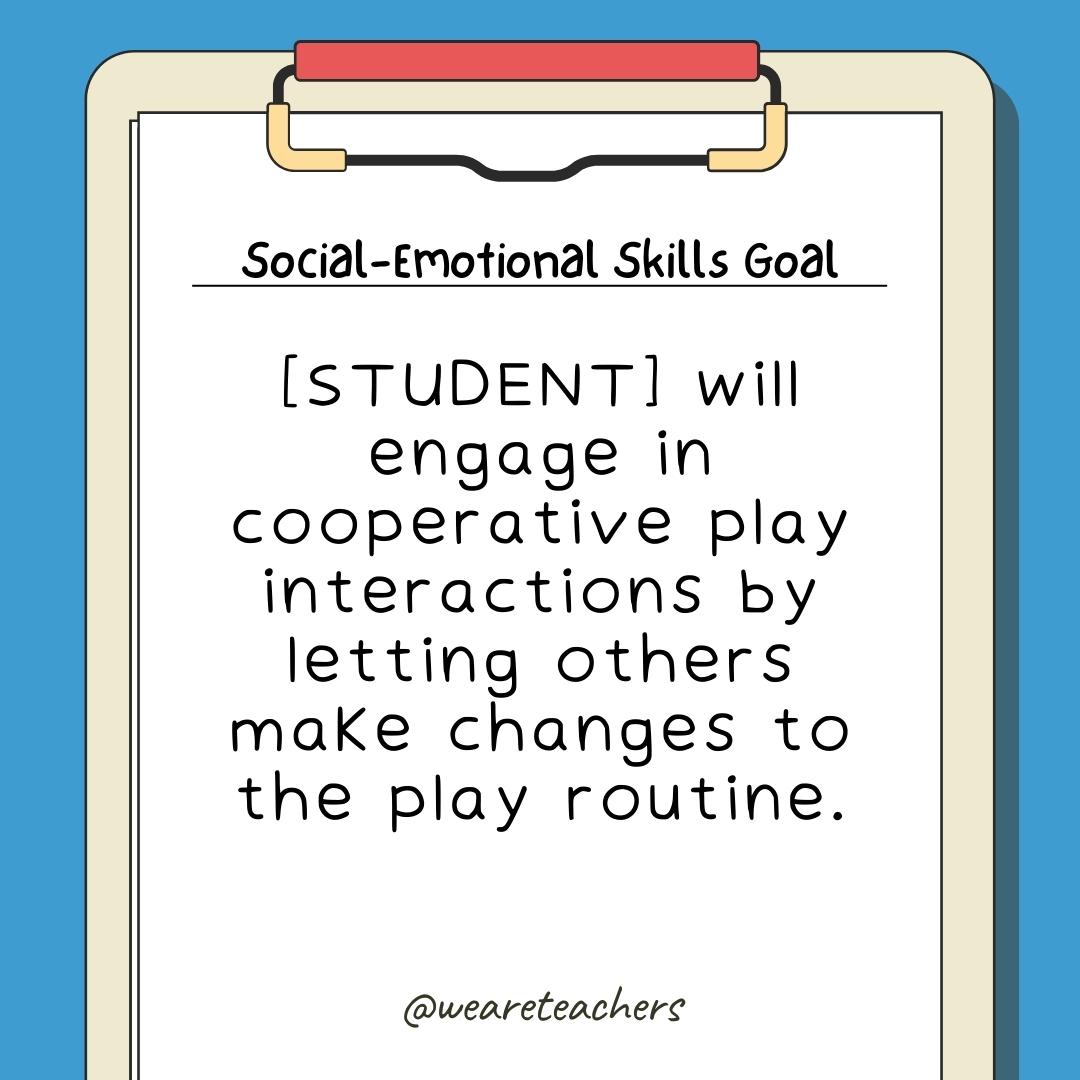
- [STUDENT] will identify appropriate social rules and expectations for various social situations.
- [STUDENT] will refrain from interrupting others.
- [STUDENT] will identify emotions presented in picture form.
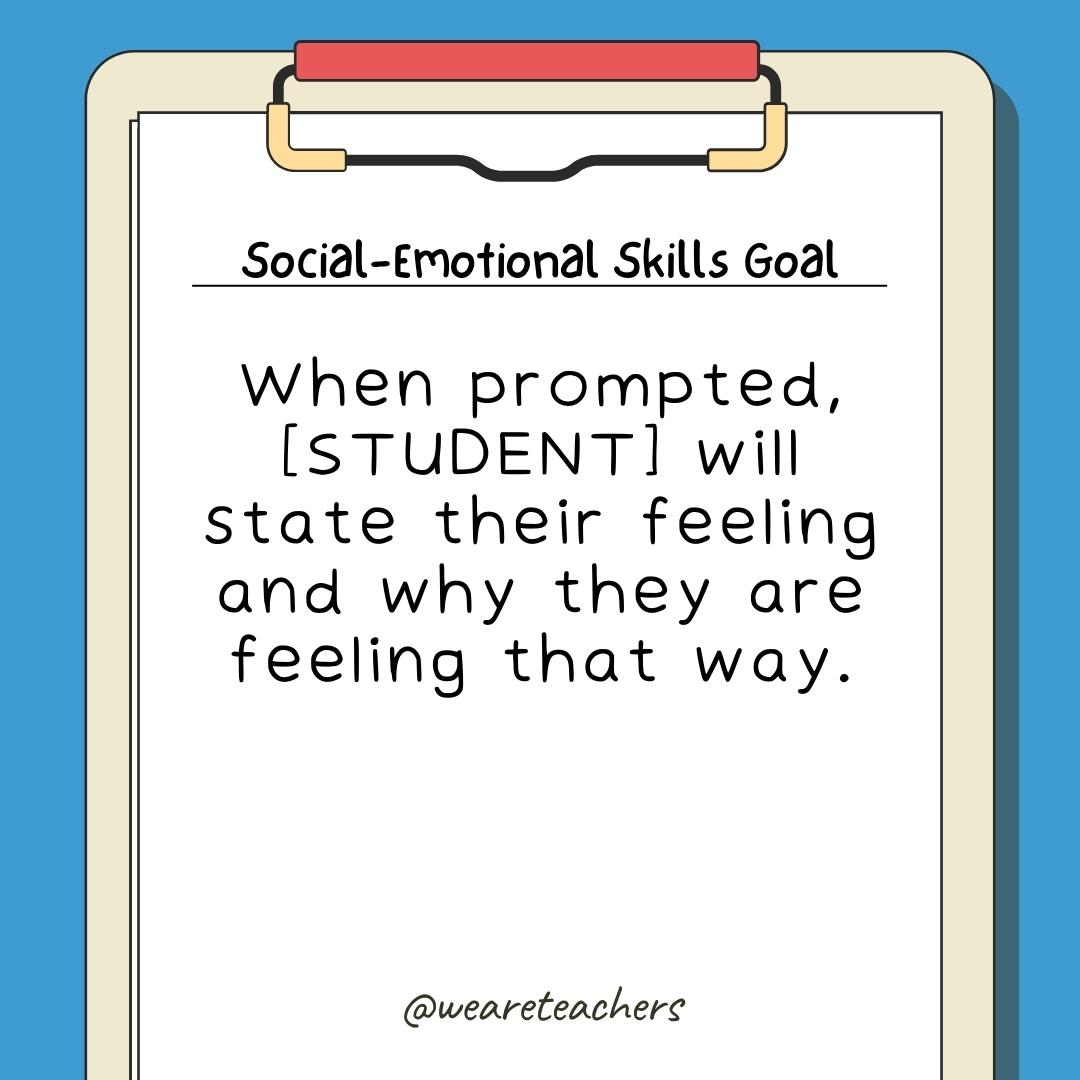
- [STUDENT] will engage in communication with others by asking questions when provided with the opportunities.
- [STUDENT] will increase or maintain conversation about a preferred or nonpreferred topic.
- Given a strategy and visual prompts, [STUDENT] will identify the signs of anxiety and apply a strategy to address feelings of anxiety in real and simulated situations.
- Given a picture scale, [STUDENT] will identify the level of anxiety they are feeling.
Executive Functioning IEP Goal Bank
Executive functioning skills are skills like planning, working memory, attention, problem-solving, mental flexibility, and self-regulation that help kids be successful in school. Students with poor executive functioning have a hard time with time management, organization, getting started with or finishing work, and connecting past experiences with current actions. (Know any kids like this?) Here’s a list of goals for helping students with executive functioning.
- Given visual cues, [STUDENT] will implement a system for organizing their backpack (locker, binder).
- Given a task and a list of materials, [STUDENT] will gather the needed items to complete the task.
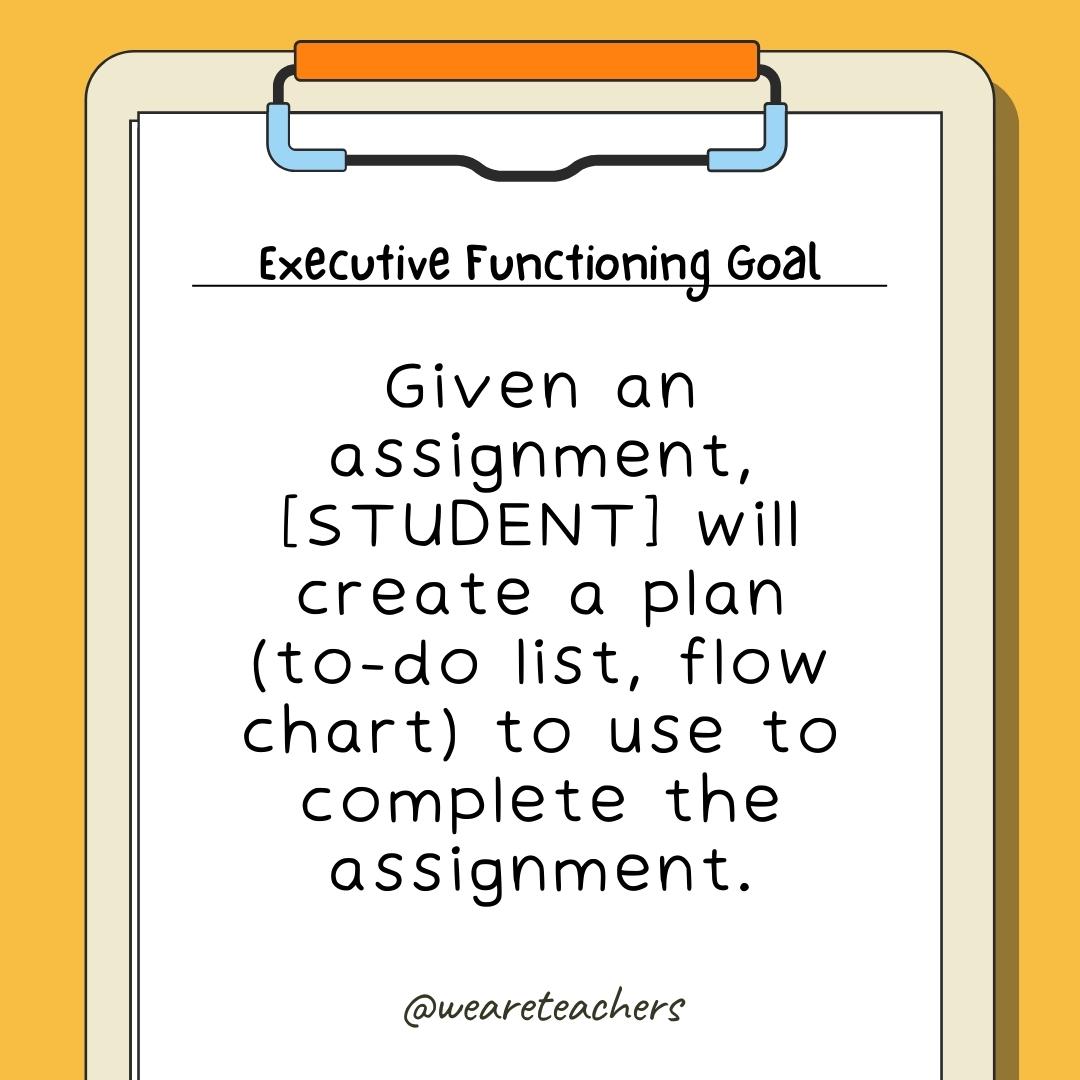
- [STUDENT] will arrive at class with necessary materials (paper, pen, computer).
- [STUDENT] will use a checklist (visual schedule) to independently complete classwork.
- [STUDENT] will respond appropriately to oral commands.
- [STUDENT] will ask for clarification and further explanation when needed.
- [STUDENT] will request desired objects or instructional materials and equipment using [picture prompts, sign language, AAC device, etc.].
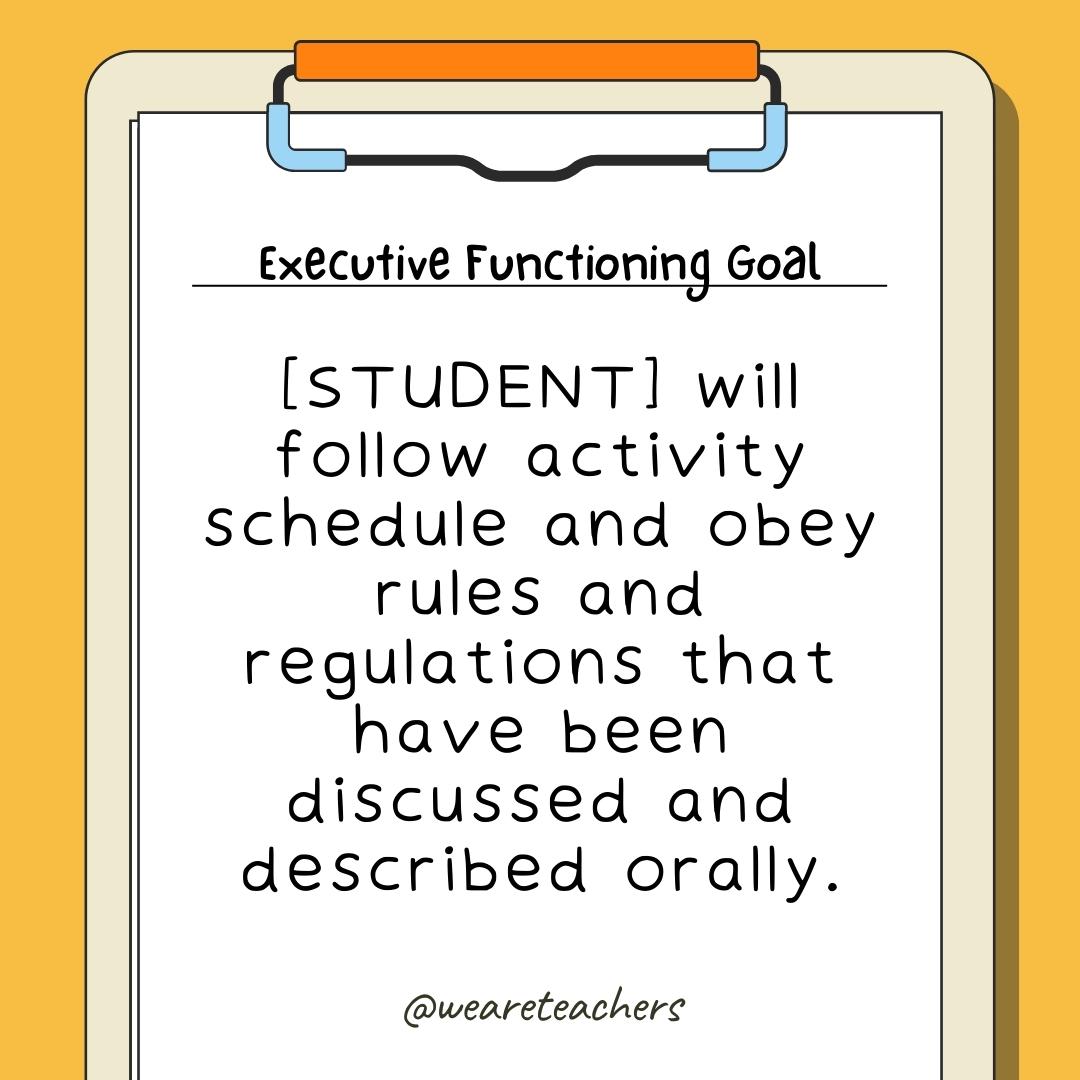
- [STUDENT] will express needs, wants, and feelings using [picture prompts, sign language, verbalization, etc.].
- [STUDENT] will create a daily visual schedule (or checklist or to-do list) and complete it.
- By the end of the IEP, [STUDENT] will demonstrate the ability to follow multiple-step directions (two or three steps) with minimal (one or two) adult prompts.
- By the end of the IEP, [STUDENT] will refer to their checklist for task completion to finish assigned work.
Self-Advocacy IEP Goal Bank
Self-advocacy goals are for skills from decision-making to goal attainment, asking for help, and speaking up for yourself. These are important skills that students need to develop, especially as they transition into independent living, college, and career.
- [STUDENT] will effectively communicate their needs and preferences in the classroom by [raising their hand, writing a note].
- [STUDENT] will use a communication notebook to write questions and concerns to the teacher one time per week.
- [STUDENT] will identify a goal, create a list of steps to achieve the goal, and work through the steps.
- Given a challenging situation to solve, [STUDENT] will define the problem and come up with two possible solutions.
- Given a task that involves a choice (e.g., the school lunch menu, a list of books), [STUDENT] will select between the options available.
![IEP-Goal-Bank-16 Given a task that involves a choice (e.g., the school lunch menu, a list of books), [STUDENT] will select between the options available.](https://www.weareteachers.com/wp-content/uploads/IEP-Goal-Bank-16.jpg)
- [STUDENT] will create a list of three personal strengths and three areas for improvement.
- [STUDENT] will actively participate in the development of their IEP goals and accommodations.
- [STUDENT] will identify one IEP goal and three objectives to support that goal.
- When faced with an academic challenge, [STUDENT] will seek assistance by raising their hand or using the classroom procedure for seeking help.
- [STUDENT] will advocate for accommodations and/or modifications in the classroom using an appropriate time, tone of voice, and language.
- [STUDENT] will demonstrate understanding of their learning preferences using a checklist, verbal communication, or another method of communication.
- [STUDENT] will engage in positive self-talk daily with and without teacher support.
- By the end of the IEP, [STUDENT] will learn and apply two self-advocacy strategies.
![IEP-Goal-Bank-17 By the end of the IEP, [STUDENT] will learn and apply two self-advocacy strategies.](https://www.weareteachers.com/wp-content/uploads/IEP-Goal-Bank-17.jpg)
- By the end of the IEP, [STUDENT] will demonstrate the ability to ask for help when needed.
- By the end of the IEP, [STUDENT] will identify and communicate two environmental requirements (e.g., “I need a movement break”).
- By the end of the IEP, [STUDENT] will engage in three conferences and/or meetings where the student will communicate their educational needs.
- [STUDENT] will explain and advocate for testing accommodations through the classroom teacher, testing center, school counselor, etc.
- [STUDENT] will reflect on their academic progress and will determine which accommodations are supporting their learning.
Get Your Free Editable and Printable IEP Goal Bank and Goal Sheets
Just fill out the form on this page to get instant access to an editable Google Doc with all the goals mentioned above as well as a bundle of four printable and editable goal-tracking sheets. Save your goal bank and access it any time to cut and paste goals into your IEP software and/or into the editable and printable goal-tracking sheets provided. The bundle includes daily and weekly tracking sheets, as well as trial tracking and progress tracking sheets for data collection.
Special education teachers are the best! Here are our favorite TikToks to make you feel seen .
Share your special education stories and connect with other teachers in our we are teachers helpline group on facebook., you might also like.
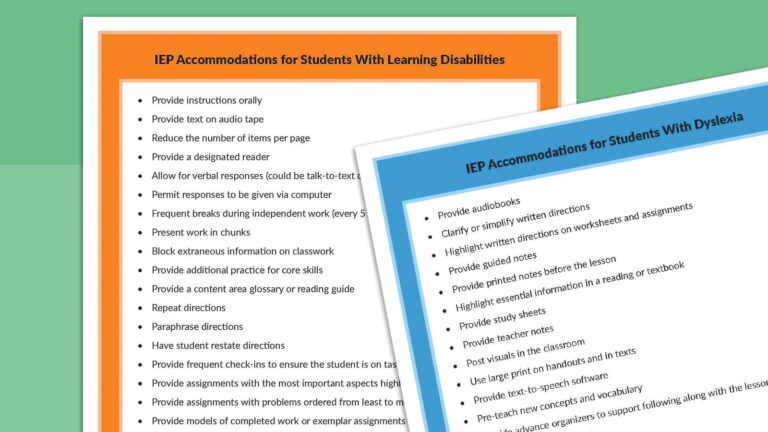
140+ IEP Accommodations Every Special Ed Teacher Should Bookmark
Plus a free printable list. Continue Reading
Copyright © 2024. All rights reserved. 5335 Gate Parkway, Jacksonville, FL 32256

Independent Functioning IEP Goals Examples

Independent functioning IEP goals are a cornerstone in the educational journey of special education students, focusing on critical life skills like safety, hygiene, food preparation, social interactions, and more. A student’s goals are created by the IEP team to cater to the unique needs of each student, ensuring that they acquire essential skills for independent living. These examples are suitable for various ages, but many would be appropriate for the older grade levels.
The Role of the IEP Team in Setting Goals
The IEP team, comprising special education teachers, parents, and sometimes occupational therapists, plays a pivotal role in developing independent functioning IEP goals. These goals are tailored to the student’s ability level and are aimed at promoting independence in various aspects of life. Special education services should provide the learning opportunities to help students achieve the specific skills referred to in the life skills IEP goals.
Keep in mind, IEP goals should always be SMART IEP goals to ensure they are measurable IEP goals to meet the individual students’ needs.
Safety Skills in Independent Functioning IEP Goals
Safety is a primary concern, and IEP goals often focus on teaching students to recognize and respond to safety cues in their environment. This could include understanding traffic signs for safe community navigation or identifying expiration dates on food for health safety. Here are five examples of goals in this area:
- Recognizing Traffic Signs : By the end of the school year, the student will correctly identify and explain the meaning of 10 common traffic signs with 90% accuracy in three consecutive trials, as measured by teacher observation and quizzes.
- Identifying Expiration Dates : The student will independently check and verbalize the expiration dates of food items during classroom activities, achieving 100% accuracy for 5 consecutive instances by the end of the semester, as monitored by the teacher.
- Emergency Response Skills : Within six months, the student will demonstrate the ability to dial emergency services and communicate their location and nature of the emergency in role-play scenarios, as observed by the teacher in four out of five attempts.
- Fire Safety Skills : The student will correctly demonstrate the steps to take during a fire drill, including evacuation routes and meeting points, in all scheduled drills throughout the school year, as recorded by the teacher.
- Understanding Personal Safety Cues : In one academic year, the student will identify and respond appropriately to 5 different personal safety scenarios (e.g., stranger danger, unsafe environments) with 80% accuracy, as assessed through role-play and teacher observation.
Hygiene and Self-Care Skills
Hygiene and self-care are critical components of independent functioning IEP goals. These goals might include tasks like dressing independently, maintaining personal hygiene, or managing personal belongings. Achieving these goals often involves direct instruction and the use of visual supports. Here are five example of goals in this area:
- Independent Dressing : Over the next four months, the student will independently select and put on appropriate clothing for the day in under 10 minutes, with 90% success rate, as recorded by the teacher and parent.
- Personal Hygiene Routine : By the end of the semester, the student will independently complete a personal hygiene routine (including teeth brushing and hand washing) every morning, as reported by parental confirmation and teacher observation.
- Managing Personal Belongings : Within the school year, the student will organize and manage their personal belongings in their locker or backpack with no more than one reminder per day, as monitored by the teacher.
- Bathroom Hygiene Skills : The student will independently follow a bathroom hygiene routine, including proper handwashing, with 95% accuracy for 30 consecutive days, as observed by teacher and school staff.
- Self-Care During Illness : By the end of the academic year, the student will demonstrate knowledge of basic self-care practices when ill (like tissue use, hand sanitizing) and verbalize when to seek adult help, in 4 out of 5 instances, as assessed by the teacher.
Food Preparation and Nutrition
Food preparation and nutrition are essential life skills. IEP goals in this area aim to teach students how to prepare simple meals, understand basic nutrition, and practice food safety. These skills are crucial for students’ health and independence. Here are examples:
- Simple Meal Preparation : In six months, the student will independently prepare three different simple, healthy meals using safe cooking practices, as observed and assessed by the teacher in practical sessions.
- Understanding Basic Nutrition : By the end of the school year, the student will identify healthy food choices versus unhealthy ones for all main meals with 85% accuracy, as measured by a teacher-made assessment tool.
- Safe Food Handling : Over the course of the school year, the student will demonstrate proper food safety techniques, including washing hands before cooking and storing food at correct temperatures, in 90% of classroom cooking activities.
- Reading Food Labels : Within three months, the student will accurately read and interpret nutritional labels on food packages for calorie content and allergens in 4 out of 5 trials, as measured by teacher assessments.
- Grocery Shopping Skills : By the end of the semester, the student will create a grocery shopping list for a healthy meal, locate items in a store, and understand the total cost, in 4 out of 5 practical trials, as monitored by the teacher or caregiver.
Developing Effective Communication Skills
Communication skills are integral to independent functioning. IEP goals might focus on helping students to express their needs, understand others, and engage in effective communication in various settings. This could involve using language skills, visual cues, or even alternative communication methods. Check out these examples:
- Expressing Needs : Within six months, the student will accurately express their needs or wants in complete sentences in 8 out of 10 observed instances, as recorded by teacher observation.
- Understanding Others : By the end of the school year, the student will demonstrate improved listening skills by summarizing what others have said in 4 out of 5 conversational exchanges, as measured by teacher and peer feedback.
- Using Visual Communication Aids : Over the next four months, the student will effectively use visual communication aids (like picture cards) to express their needs in 90% of daily interactions, as tracked by the teacher.
- Initiating Conversations : In the next three months, the student will initiate appropriate conversations with peers and adults in 75% of social opportunities, as observed and recorded by school staff.
- Understanding Nonverbal Cues : Within this academic year, the student will correctly interpret and respond to nonverbal communication cues in social interactions in 80% of instances, as measured by role-play assessments and peer feedback.
Social Skills and Emotional Regulation
Social skills and appropriate emotional responses are vital for successful interactions. IEP goals might include learning to interpret social cues, engage in appropriate behavior in social settings, or use appropriate coping strategies for emotional regulation. Here are a few examples:
- Interpreting Social Cues : By the end of the semester, the student will correctly interpret and respond to common social cues (like facial expressions and body language) in 85% of interactions, as recorded by teacher observation.
- Appropriate Behavior in Social Settings : In the next six months, the student will demonstrate appropriate behavior (e.g., waiting their turn, respecting personal space) in social settings in 9 out of 10 instances, as measured by teacher and peer observations.
- Using Coping Strategies : Throughout the school year, the student will use taught coping strategies (like deep breathing, counting to ten) to manage emotions in 80% of challenging situations, as monitored by teacher and school counselor.
- Developing Friendship Skills : Within nine months, the student will initiate and maintain a reciprocal conversation with a peer for at least 5 minutes in 4 out of 5 opportunities, as observed by the teacher.
- Handling Social Conflicts : By the end of the school year, the student will demonstrate appropriate strategies to resolve common social conflicts in 4 out of 5 role-play scenarios, as assessed by the school counselor.
Executive Functioning Skills
Executive functioning skills such as task initiation, time management, and problem-solving are crucial for independent living. IEP goals in this area might focus on helping students plan and complete tasks, organize their work, and make appropriate decisions. Read this ideas to help you get started:
- Task Initiation : Within the next four months, the student will independently begin assigned tasks within 5 minutes of instruction in 80% of classroom activities, as recorded by the teacher.
- Time Management : By the end of the semester, the student will effectively use a planner or digital tool to manage their time for schoolwork, completing assignments on time in 90% of cases, as observed by the teacher.
- Problem Solving Skills : In six months, the student will independently solve simple daily problems (like what to do if they forget their lunch) with minimal adult intervention in 85% of occurrences, as recorded by teacher observation.
- Organizing School Work : Throughout the school year, the student will maintain an organized binder or digital folder for classwork with all materials correctly filed in 95% of school days, as monitored by the teacher.
- Decision Making in Real-life Scenarios : By the end of the school year, the student will demonstrate the ability to make appropriate decisions in real-life scenarios (like choosing appropriate clothes for weather) in 4 out of 5 instances, as observed by the teacher and family members.
Academic and Classroom Task Management
Managing academic and classroom tasks is also a focus of independent functioning IEP goals. These goals aim to enhance the student’s ability to handle homework assignments, participate in classroom activities, and use tools like graphic organizers effectively. Here are examples:
- Homework Completion : Over the next three months, the student will complete and submit homework assignments on time for all academic tasks with 90% accuracy, as recorded by the teacher.
- Participation in Classroom Activities : In the next six months, the student will actively participate in classroom discussions and group activities in 4 out of 5 opportunities, as observed by the teacher.
- Using Graphic Organizers : By the end of the semester, the student will independently use graphic organizers to plan and write essays in English class with 85% accuracy, as assessed by the teacher.
- Following Classroom Routines : Throughout the school year, the student will follow classroom routines using a self-regulation checklist with minimal reminders in 95% of school days, as monitored by the teacher.
- Managing Classroom Materials : In four months, the student will independently gather and organize necessary materials for classroom tasks in 9 out of 10 instances, as observed by the teacher.
Transition Plans for Future Independence
As students approach the end of their school years, IEP goals often include transition plans. These goals are designed to prepare students for post-school life, focusing on skills required for employment, further education, or living independently. Here are five examples:
- Employment Skills : By the end of the school year, the student will demonstrate basic job-related skills (like punctuality, following instructions) in a school-based work experience setting in 90% of opportunities, as observed by the teacher and work supervisor.
- Independent Travel Training : Over the next six months, the student will learn and demonstrate the ability to use public transportation independently, including planning routes and paying fares, in 4 out of 5 trials, as measured by teacher and caregiver observations.
- Post-School Education Planning : In the next academic year, the student will research and identify three potential post-secondary education options that match their interests and skills, as documented in their transition plan.
- Independent Living Skills : By the end of the school year, the student will demonstrate the ability to perform three independent living skills (like laundry, budgeting, apartment searching) with 85% accuracy, as measured by practical assessments and family feedback.
- Community Participation Skills : Within the next nine months, the student will participate in three different community activities or events, demonstrating appropriate social and communication skills, as observed by the teacher and community members.
Occupational Therapy and Additional Support
Occupational therapy and additional support play a significant role in achieving independent functioning IEP goals. Therapists and special education teachers work together to provide the necessary supports, using tools like task cards and step-by-step instructions to facilitate learning.
More Helpful IEP Goal Examples
For more insights and examples of IEP goals, explore these resources:
- Self-Advocacy IEP Goals
- Social-Emotional IEP Goals
- Executive Functioning IEP Goals
- IEP Transition Goals
- Prevocational IEP Goals
- Study Skills IEP Goals
- How to Write SMART Annual Goals
- Occupational Therapy IEP Goals
Independent functioning IEP goals are tailored to equip special education students with the necessary skills for a self-reliant and fulfilling life. These goals, crafted with care and precision, cover a wide range of skills, ensuring that each student is prepared for the challenges of daily living and future endeavors.

Your Therapy Source
Email: [email protected] Phone: (800) 507-4958 Fax: (518) 308-0290


Independent Functioning IEP Goals: Examples and Templates to Save You Time
In this post you will learn about independent functioning IEP goals and how you can write them to save you time.
Independent living is one of the major outcomes of an IEP. So, preparing for it should ideally start from earlier education levels and working on these skills throughout their education.
That said, independent functioning IEP goals might look different for different students , depending on the student’s abilities, age, and what their caretakers are focused on.
Working with the school district and the student’s guardians should help you choose what independent functioning skills to add to your IEP goals. So here are some examples with various goals to help you and save you time.
Templates for IEP Goals
If your school district doesn’t specify a template for IEP goals, it could get a bit challenging to find one that’s both versatile and all-encompassing. Here are a couple I found helpful that include most parameters you should include in your goal development :
- By (insert date), given (number & type of) prompts , (the student) will (accomplish goal), in (number/percentage of) trials over (number of) consecutive (days, weeks, or months) as measured by (testing methodology).
- Given (accommodations, prompts), (the student) will (accomplish goal) in (conditions, setting), (to what extent) by (a certain date) as evaluated by (evaluation methodology).

Examples of Independent Functioning IEP Goals
The skills needed to live and function independently are widely varied and include many subcategories. For the sake of being thorough, I’ve divided them into goal clusters that should cover most bases and give you ideas to add more goals as you see fit.
Independent Functioning IEP Goals: Nutrition Goals
- Hold and use a utensil correctly.
- Put an appropriate bite of food on the utensil and eat it.
- Chew the food adequately with the mouth closed.
- Try new flavor combinations.
- Wait for the food to cool and take small bites.
- Identify different food courses and savory/sweet foods that go in each one.
- Clear the table at home and put used plates and utensils in the sink.
- Wash hands before and after eating.
- Pack away leftover food before refrigerating.
- Pass around food and utensils at large gatherings.
Independent Functioning IEP Goals: Hygiene and Grooming Goals
- Correctly identify body parts (by pointing at them).
- Identify tools for personal hygiene (hairbrush, toothbrush, soap, tap, bath, washcloth)
- Wash the face every morning.
- Brush teeth after every meal.
- Swish water or mouthwash without swallowing.
- Floss teeth (with regular floss or floss pick).
- Differentiate between hygiene products and household cleaning products.
- Use the bathtub to clean the body.
- Brush and style hair (curl, straighten, or use styling products)
- Apply deodorant thoroughly (roll-on or stick)
- Ask to use the restroom when needed and reply yes/no when asked.
- Follow a restroom use routine.
- Identify the correct restroom stall.
- Close the stall door.
- Adjust clothing before and after restroom use.
- Use toilet paper correctly.
- Flush the toilet correctly.
- Wash hands after using the toilet.
For more personal hygiene strategies, click here .
Independent Functioning IEP Goals: Dressing Goals
- Identify the correct orientation of clothing (front, back, inside, and out).
- Learn how to put on underwear (boxers, briefs, bras, and undershirts).
- Learn how to put different tops on and off (T-shirts, shirts, and jackets).
- Learn how different bottoms go on and off (jeans, pants, and sweatpants).
- Learn how different shoes are fastened (velcro, tie, and slip-on).
- Identify season-appropriate clothing and how to tell the weather outside.
- Identify the correct personal clothing and shoe size when shopping.
- Learn about accessories.
- Loop belts through pants and buckle them.
- Choose handbags or purses.
- Pick out jewelry (earrings, rings, bracelets, and necklaces).
- Learn how to take off accessories and store them after wear.
- Dress oneself fully.
- Learn about dressing for an occasion (work, dinner, a casual get-together, etc.).
- Choose an outfit independently.
- Change into the correct outfit when it’s time to go out.
For more dressing strategies, click here .
Get the FREE Life Skills Curriculum Year at a Glance Planner full of Life Skills Ideas!
Click HERE or the image below to get the free life skills year-at-a-glance curriculum teaching ideas!

Independent Functioning IEP Goals: Safety Goals
- Identify edible and inedible items around the house.
- Identify choking hazards in edible foods.
- Identify hazardous items around the house (sharp knives, hot iron, etc.).
- Participate in fire, earthquake, and lockdown drills.
- Follow directions from authority figures during drills.
- Dial 911 during personal emergencies only.
- Identify community workers and what they respond to.
- Learn how to describe an emergency to a responder.
- Locate the fire extinguisher and learn how to operate it.
- Locate the first aid kit and learn how to use every item.
- Operate a cell phone.
- Locate or dial emergency contact numbers on the cell phone.
- Learn about boundaries with strangers.
- Learn to search for a trusted figure in uncomfortable situations.
- Learn when to answer the door when home alone and when not to.
- Learn how to avoid or clear dangerous materials like cleaning chemical spills or broken glass.
- Learn what to place inside a microwave oven and what not to.
- Learn about expiry dates and how to dispose of spoiled food.
- Learn what to do when you finish cooking (turn off the stove and open a window).
- Learn what to do before leaving the house (close windows, blow out candles, and lock doors)
For kitchen safety resources, click here .
Independent Functioning IEP Goals: Communication Goals
- Identify name, address, and social security number on written documents.
- Write name and address when needed.
- Identify different types of written documents, like bills, letters, etc.
- Use a computer for written tasks.
- Use a web browser to access the internet.
- Learn about internet safety and how to communicate with strangers on the internet.
- Operate a cell phone for phone calls.
- Use the internet to shop for items.
- Use the internet to pay bills.
- Use the features on a smartphone like texting and accessing the internet.
Independent Functioning IEP Goals: Miscellaneous Goals
- Identify different furniture for various uses around the house.
- Call a professional when something breaks around the house (a plumber for water leaks, an electrician for broken light fixtures, etc.).
- Care for houseplants.
- Care for a pet.
- Keep the house in order (cleaning, tidying up, and doing laundry).
- Operate small appliances in the kitchen (blender, hand mixer, microwave oven, etc.).
- Read labels to know what’s inside a container.
- Read price tags and labels to identify item prices.
- Use cash or a debit card to pay for purchased items.
Are You Looking for Additional Help and Strategies for Functional Life Skills?
Check out my new Functional Life Skills Toolkit . It includes step-by-step resources for task analysis and goal development for autistic children, teens, and young adults.
Other Functional Life Skills Resources for You
The Mega Bundle of Functional Life Skills Resources for Teens and Adults
The Best Functional Life Skills Resources for Individuals with Autism
Breaking Barriers: Life Skill Goals for Teaching Independence
Executive Functioning Challenges with Task Initiation: Resources to Help Teach Life Skills

Submit a Comment Cancel reply
Your email address will not be published. Required fields are marked *
This site uses Akismet to reduce spam. Learn how your comment data is processed .
Privacy Overview

IEP Goal Bank & Goal Writing Resources
Browse our FREE Common Core aligned IEP goal bank! Find socio-emotional and academic goals and objectives in reading, writing, and mathematics for your students, along with sample baselines, assessment ideas, and modification ideas!
Socio-Emotional Goal Bank
Strengths and skills focused socio-emotional goals with intervention ideas
Mathematics Goal Bank
Common Core aligned IEP goals for word problems, computation, and number sense
Reading Goal Bank
Common Core aligned goals for decoding, fluency, inferencing, and comprehension
Writing Goal Bank
Common Core aligned goals for fluency, facts, word problems, & number sense & more
Tips for Writing IEP Goals
- Tip #1: Limit Your Goals
- Tip #2: Find Key Standards
- Tip #3: Look at the Assessments
- Tip #4: Serve the Whole Student
- Tip #5: Listen to the Family
Don’t overload the goals! IEP goals are supposed to be what you work on in addition to the state standards. The goals are what you focus on in interventions– and you can’t focus on everything at once!
My rule of thumb is up to two goals per subject area:
- A reading comprehension and a procedural reading (decoding/fluency/level) goal
- A math problem solving and procedural (number sense, addition, etc) goal
- A writing content (narrative, paragraph, etc) and procedural (spelling, fluency, typing) goal
- A self-regulation or advocacy goal
- One other socioemotional goal as needed.
Those ten goals would enable you to provide support across all key subjects and on socioemotional skills! For students with fewer needs, I do even fewer goals.
If a student has related services, conference with the providers and combine your goals! Students are going to grow more if you are all rowing in the same direction– and focusing on the same key skills! Find ways to combine your goals.
When it comes to actually writing the goals, work from key standards. What are the standards that 1) hit on students’ areas of need; and 2) are worth working on again and again and again all year long?
All of the goals in Spedhelper’s goal banks have been carefully chosen to reflect key standards. Don’t like our goals? Steal the standards and write your own!
Focus goals on students’ key areas of need– the areas where they are the most below grade level. And think about the bigger picture– what are the deficits that are likely to compound and keep them from accessing the general education curriculum?
Don’t limit yourself to academic goals! Students need more than content knowledge to succeed in school. Think about socioemotional needs too. Does the student stand up for themself? Can they request accommodations as needed? Do they have impulse control strategies to draw on?
All of us (me included!) have socioemotional needs. Our goal is for our students to become successful, independent learners….. what socio-emotional skills are there that might help them get there?
This is the biggest one! The law says parents need to be involved. Don’t make parent participation a check box! Talk to the family before the IEP and get to know what goals they want to see for their child!
Families know their children better than we ever will so draw on them as a resource. They might not be able to give you a writing goal– but they are really likely to have amazing ideas on self-advocacy goals and organization goals!
Letters, Sounds, and Sight Words Goals

Fluency & Decoding Goals
Non-fiction comprehension goals.

Fiction Comprehension Goals
Spelling goals, grammar & complete sentences goals, paragraphs & narratives goals, writing fluency goals, number sense goals.

Addition & Subtraction Goals
Multiplication & division goals.

Word Problem Goals
School safety goals, classroom success goals, self-regulation goals, self-advocacy goals, need teaching resources or case management tools check out the store.

K-5 Custom Goal Creator for Academic Goals
- Add to cart

IEP Writing Success Kit: MEGA Bundle with PreK-5 Special Education Assessments and Goals

Encoding Sounds Assessment for IEPs and Progress Monitoring

Accommodations & Modifications Matrix for IEPs
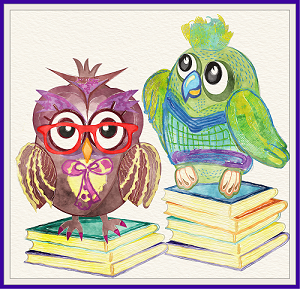
Oh hi there It’s nice to meet you.
Sign up to be the first to learn about sales and new content.
We don’t spam! Read our [link]privacy policy[/link] for more info.
Check your inbox or spam folder to confirm your subscription.
Search This Blog
The school psych toolbox.
Useful tips, tools, strategies, and topics for School Psychologists, Special Educators, Teachers, Administrators, and Parents
IEP Goal Bank

Post a Comment
Popular posts from this blog, the "self & match" system.
Emotional and Behavioral Disorders, an introduction
The move to application based assessment.

Math IEP Goals For Special Education
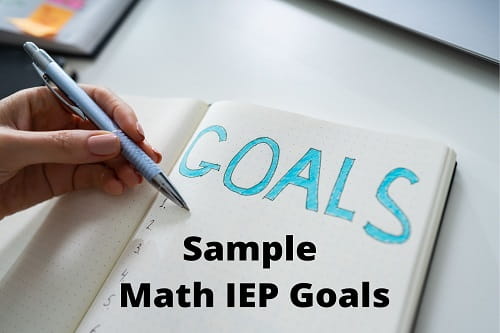
Drafting IEP goals can be difficult, so here are a few math IEP goals (across various ability levels) to get you started. Please adapt and modify to meet the specific needs of your students. Keep in mind a goal should be a skill you believe is achievable by the student in 1 school year. You can always do an addendum if a student has met all criteria for the goal/objectives.
Remember, when writing objectives, break down the goal into smaller steps. You can lessen the percentage of accuracy, the number of trials (3/5 vs 4/5), or amount of prompting. Just make sure the objectives build on each other and are working towards mastery.
The reason why I always list accuracy at 100% when writing Math goals is because the answer is either right or wrong, an answer to a math problem can’t be 50% correct. So feel free to play with the ## of trials for accuracy.
Number Identification:
Goal: Student will independently identify numbers 1-20 (verbally, written, or pointing) with 100% accuracy on 4 out of 5 trials measured quarterly.
Goal: When verbally prompted by teacher to “point to the number _________”, Student will independently select the correct number with 100% accuracy on 4 out of 5 trials measured quarterly.
Goal: Student will independently count in rote order numbers 1-25 with 100% accuracy on 4 out of 5 trials measured quarterly.
Goal: Student will independently count by 2, 3, 5, 10 starting from 0-30 verbally or written, with 100% accuracy on 4 out of 5 trials measured quarterly.
One-to-one Correspondence:
Goal: When given up to 10 objects, Student will independently count and determine how many objects there are (verbally, written, or by pointing to a number) with 100% accuracy on 4 out of 5 trials measured quarterly/monthly.
Goal: When given up to 10 items/objects, Student will independently count and move the items to demonstrate 1:1 correspondence and identify how many there are with 100% accuracy on 4 out of 5 trials measured quarterly.
Goal: Given 10 addition problems, Student will independently add single digit numbers with regrouping with 100% accuracy on 4 out of 5 trials as measured quarterly.
Goal: Student will independently add a single digit number to a double digit number with and without regrouping with 100% accuracy on 4 out of 5 trials measured quarterly.
Goal: Student will independently add double digit numbers to double digit numbers with (or without) regrouping with 100% accuracy on 4 out of 5 trials measured quarterly.
Adding with Number Line:
Goal: Given 10 addition problems and using a number line, Student will independently add single digit numbers with 100% accuracy on 4 out of 5 trials measured quarterly.
Subtraction:
Goal: Student will independently subtract a single digit number form a double digit number with and without regrouping with 100% accuracy on 4 out of 5 trials measured quarterly.
Goal: Given 10 subtraction problems, Student will independently subtract double digit numbers from double digit numbers with and without regrouping with 100% accuracy on 4 out of 5 trials measured quarterly.
Goal: Student will independently subtract money/price amounts from one another with and without regrouping, while carrying the decimal point with 100% accuracy on 4 out of 5 trials as measured quarterly.
Goal: Using a number line, Student will independently subtract numbers (20 or less) with 100% accuracy on 4 out of 5 trials measured quarterly.
Telling Time:
Goal: Student will independently tell time to the half hour on an analog clock (verbally or written) with 100% accuracy on 4 out of 5 trials measured quarterly.
Goal: Student will independently tell time to the hour on an analog clock (verbally or written) with 100% accuracy on 4 out of 5 trials measured quarterly.
Elapsed Time:
Goal: Given a problem with a start time and end time, Student will independently determine how much time has elapsed with 100% accuracy on 4 out of 5 trials measured quarterly.
Goal: Given a problem with a start time and duration of activity/event, Student will independently determine what the end time is with 100% accuracy on 4 out of 5 trials measured quarterly.
Dollar More:
Goal: Using the dollar more strategy, Student will independently identify the next dollar up when given a price amount with 100% accuracy on 4 out of 5 trials measured quarterly.
Goal: Student will independently identify the next dollar amount when given a price, determine how much is needed to make the purchase, and count out the necessary amount (using fake school money) with 100% accuracy on 4 out of 5 trials measured quarterly.
Goal: When given a price, student will identify which number is the dollar amount with 100% accuracy on 4 out of 5 trials measured quarterly.
Money Identification/Counting Money:
Goal: When given a quarter, dime, nickel, and penny, Student will identify the coin and corresponding value with 100% accuracy on 4 out of 5 trials measured quarterly.
Goal: When given a random amount of coins (all of one type), Student will independently count the coins with 100% accuracy on 4 out of 5 trials measured quarterly.
Goal: When given a mix of coins (to include quarter, dime, nickel, penny), Student will independently count the coins with 100% accuracy on 4 out of 5 trials measured quarterly.
Goal: When given a mixture of coins and dollar bills, Student will independently count the money with 100% accuracy on 4 out of 5 trials measured quarterly.
Goal: When give 2, 3, and 4 digit numbers, Student will independently round to the nearest tens, hundreds, thousands independently with 100% accuracy on 4 out of 5 trials measured quarterly.
Greater than/Less than:
Goal: Given 2 numbers, pictures, or groups of items, Student will independently determine which number is greater than/less than/equal by selecting or drawing the appropriate symbol (<,>, =) with 100% accuracy on 4 out of 5 trials measured quarterly.
Goal: Student will independently count objects or pictures of objects and tally the corresponding amount (up to 15) with 100% accuracy on 4 out of 5 trials as measured quarterly.
Goal: Given a number, up to 20, Student will independently tally the corresponding number with 100% accuracy on 4 out of 5 trials measured quarterly.
Goal: Given data and a bar graph template, Student will independently construct a bar graph to display the data and answer 3 questions about the data with 100% accuracy on 4 out of 5 trials measured quarterly.
Goal: Given a line, pie, or bar graph, Student will independently answer questions about each set of data with 100% accuracy on 4 out of 5 trials measured quarterly.
Goal: Given data and a blank graph template, Student will independently construct the graph to display the appropriate data with 100% accuracy on 4 out of 5 trials measured quarterly.
Goal: Student will independently identify the numerator and denominator in a fraction with 100% accuracy on 4 out of 5 trials measured quarterly.
Goal: When given a picture of a shape divided into parts, Student will independently color the correct sections in to represent the fraction given with 100% accuracy on 4 out of 5 trials measured quarterly.
Goal: Student will independently add fractions with like denominators with 100% accuracy on 4 out of 5 trials measured quarterly.
Word Problems:
Goal: Student will independently solve one step addition and subtraction word problems with 100% accuracy on 4 out of 5 trials measured quarterly.
Goal: Student will independently solve two step word problems (mixed addition and subtraction) with 100% accuracy on 4 out of 5 trials measured quarterly.
Goal: Student will independently solve one and two step multiplication world problems with 100% accuracy on 4 out of 5 trials measured quarterly.
Goal: Student will independently read a one or two step word problem, identify which operation is to be used, and solve it with 100% accuracy on 4 out of 5 trials measured quarterly.
Goal: Given a word problem, Student will independently determine which operation is to be used (+,-,x, /) with 100% accuracy on 4 out of 5 trials measured quarterly.
Even/Odd Numbers:
Goal: When given a number, student will independently identify if the number is odd or even (written or verbally), with 100% accuracy on 4 out of 5 trials measured quarterly.
Measurement:
Goal: Given varying lines and objects, Student will independently estimate the length of the object/picture, measure it using a ruler, and identify how long the object/picture is with 100% accuracy on 4 out of 5 trials measured quarterly.
Multiplication:
Goal: Student will independently solve 10 multiplication facts (2, 3, and 5 facts) with 100% accuracy on 4 out of 5 trials measured quarterly.
Goal: Student will independently solve 20 multiplication facts (facts up to 9) with 100% accuracy on 4 out of 5 trials measured quarterly.
Goal: Given a division problem (where the divisor is _____), Student will independently solve it with 100% accuracy on 4 out of 5 trials measured quarterly.
Feel free to use and edit as necessary. It’s up to you how often you want to measure the goals, but remind parents that even if the goal says 5/5 times quarterly, it doesn’t mean you’re only working on it those 5 times. That is just the number of times you’ll take official data. Just make sure it’s a reasonable ## so you have time to take all the data you need. Especially if you have multiple goals/objectives to take data for!
Happy drafting!
Where should we send your
Free lesson plans, success check your email for your free lessons.
We hate SPAM and promise to keep your email address safe.
Want some lesson plans you can immediately use?
Enter your email address below to get 5 free lesson plans now .
Helping Your Baby Reach Greater Wonders
5 Sample Self-Advocacy IEP Goals

- Goal-setting meetings with the IEP team are an important step to determine what changes are necessary to teach students best and help accomplish the student’s individual, unique goals.
- The ability to self-advocate takes time and practice to develop.
- Students can develop self-awareness and problem-solving skills to effectively communicate with parents, teachers, and support personnel.
“Speak up!”
Those words can be heard in a variety of ways.
Sometimes they can be harshly spoken, with overtones of frustration and condescension, leaving the listener with a sense of feeling small, unseen, or inferior.
At other times, they can be a powerful call to action. A stirring invitation to practice self-advocacy skills and articulate concerns about our own behaviors or those of the people around us.
For children with physical, cognitive, emotional, or learning disabilities, learning how to advocate for their needs in an educational setting by working towards goals identified in an IEP requires learning strategies and advocacy skills to give voice to their unique goals, concerns, and challenges.
Learning to advocate for yourself—whether in an educational, healthcare, or other setting—is a lifelong process that takes time, practice, and repetition to build skill. Read on to see how self-advocacy skills can be developed through five sample areas of an IEP.
Goal #1: Requesting Accommodations
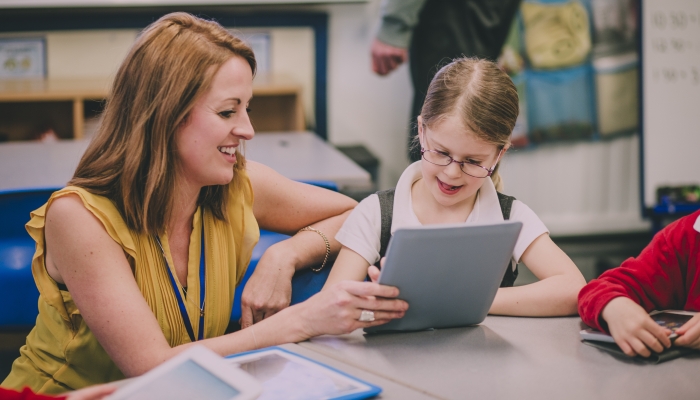
The terms “accommodations” and “modifications” can be used interchangeably in the realm of special education. However, each has a specific meaning and application in an educational or classroom setting.
Accommodations
Accommodations 1 1. Harris, K.. Accommodations vs Modifications in Education. Modern Teacher . 2022. https://modernteacher.net/accommodations-vs-modifications refer to “changes made to the way instruction is delivered or to the way the curriculum is accessed by the student.”
In other words, the student in question is learning the same content as the rest of the class, but how the student is learning that content is changed.
Examples of real-world accommodations could be a visually impaired student using assistive technology during class to access lesson content, adaptive physical education , or a student with a learning disability or ADHD being given lesson notes from the teacher to supplement those the student takes during lecture.
All students, whether or not they have an individualized education program ( IEP ) or 504 plan in place, may need accommodations at different points in their schooling.
Accommodations can be formal (outlined in an IEP meeting and legally binding) or more informal (given at the discretion of each classroom teacher and may vary from year to year, based on the individual needs of the child).
Modifications
In education, modifications are considered “changes made to the content or curriculum that the student is expected to learn.”
Restated, modifications mean that what the student learning has changed.
Because students with modifications receive different content and instruction, these needs tend to be formally identified and communicated in each student’s individualized education program.
Ideally, students will take an active role in determining what accommodations or modifications will help them accomplish their individual learning goals and request to use their specific accommodations in the classroom setting when needed.
A sample IEP goal for requesting accommodations could include:
- The student will request specific accommodations in the classroom setting when needed.
Goal #2: Participating in IEP Meetings
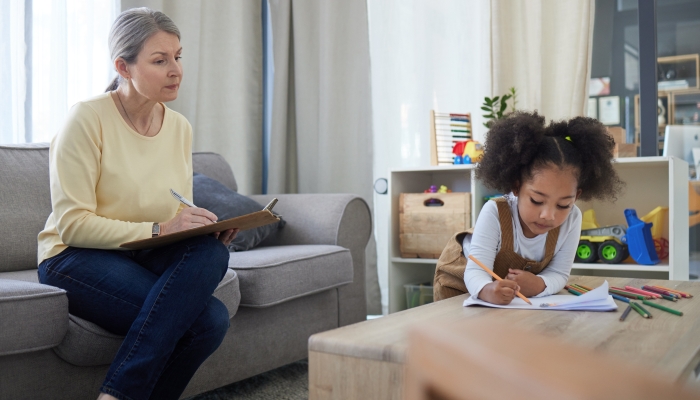
Empowering students to actively participate in their IEP meetings is an important skill and a vital part of the IEP process. No one knows what it’s like to live with your student’s unique challenges in a classroom setting better than your child.
Does your student balk at the idea of attending or being a part of their IEP meeting? Consider involving your child in alternative ways, such as:
- Role-playing scenarios or practicing questions that are likely to be asked during the meeting.
- Asking your child’s classroom teacher, special education teacher, or school counselor for questions that are typically asked during an IEP meeting . Talking about and preparing these answers at home may help reduce your child’s social anxiety or nervousness about speaking in front of a group of adults.
- Asking your child to write brief responses to some of the interview questions, or allowing them to dictate their answers while you write them down. Include examples to help your student express their ideas or concerns.
- With your child’s permission, using audio and/or visual recordings to ask them IEP interview questions in a familiar setting. This option allows your child to “attend” the meeting without actually having to be present.
Assist your child in setting their own, achievable goals for their education each year. This important information helps guide the actions of the IEP team and allows your child to build self-confidence as they develop these skills.
A potential IEP goal for participating in IEP meetings could be:
- The student will actively participate in their IEP meeting, including setting personal goals.
Goal #3: Developing Self-Monitoring Skills
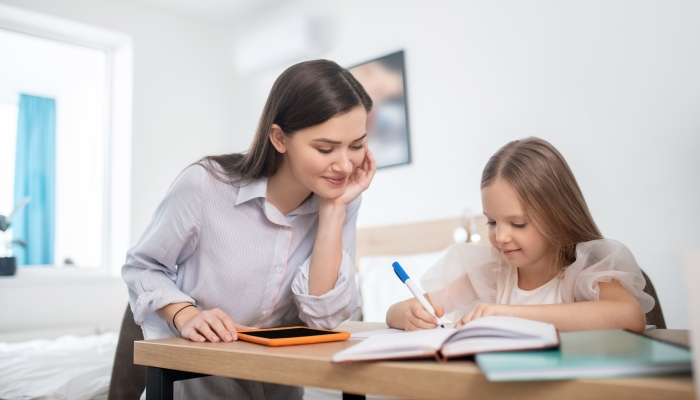
Are the identified academic and behavioral strategies working for your student?
Ideally, each student will develop an awareness of their own capabilities and learning strengths over time, as well as how those skills impact individual progress toward their academic and self-regulatory goals.
How can children work to develop this self-monitoring piece?
According to staff at Wilson College 2 2. Benefits and Examples of Student Self-Assessments. Wilson College . 2024. https://online.wilson.edu/resources/examples-of-student-self-assessment , student self-assessment allows learners to be active participants in what they’re learning and to reflect on how they learn.
This reflection has a positive impact on cognitive processes like problem-solving, learning, and decision-making skills for future learning experiences.
Self-assessment tools that can be used by students after direct instruction from a teacher include:
- Learning logs. Also known as a personal learning journal, these logs serve as a data record for each student’s progress towards their IEP and learning goals. It also gives students a dedicated space to log their ideas and questions about learning, while tracking progress toward their academic, self-awareness, and self-advocacy goals.
- Reflective journals. Similar to a learning log, reflective journals tend to be less structured and centered around objective format or data. There are many different kinds of reflective journals available for students, including digital or video formats.
- Goal-setting . The use of SMART (specific, measurable, achievable, relevant, and time-bound) goals helps students move towards self-efficacy and provides a sense of accountability for their own learning progress.
- Rubric self-assessment . A rubric 3 3. Using rubrics. Center for Teaching Innovation: Cornell University . https://teaching.cornell.edu/teaching-resources/assessment-evaluation/using-rubrics#:~:text=A%20rubric%20is%20a%20type,projects%2C%20portfolios%2C%20and%20presentations. outlines specific expectations for an assignment. Using a rubric self-assessment tool can give students a sense of how their work compares to a clear, impartial standard or framework and identify growth areas in their learning.
- Questionnaires or surveys . Regular use of these tools allows the student to give input into what strategies are or are not working, which may help decrease unwanted negative behaviors in the classroom and aid in developing goal-setting skills.
- Self-reflection worksheets. By using a simple format with open-ended questions or a structured rating scale, these forms allow students to describe the learning experience as a whole, their role and progress towards that learning, and identify areas of growth that will allow them to progress towards their learning goals.
- Exit tickets . These short reflections or responses at the end of a learning session help teachers get a sense of how well the student understood the material, identify any learning gaps, and plan future strategies or interventions to help students better understand the material.
Student knowledge, participation, and ownership of their vital role in their role in achieving IEP goals go a long way towards building self-confidence and independence—in the classroom setting and the world beyond.
Possible goals for developing self-monitoring skills could look like:
- The student will choose one or two self-assessment methods to use during the semester.
- The student will actively participate in the completion of a self-assessment tool 4 out of 5 times during the school week.
Goal #4: Enhancing Communication Skills
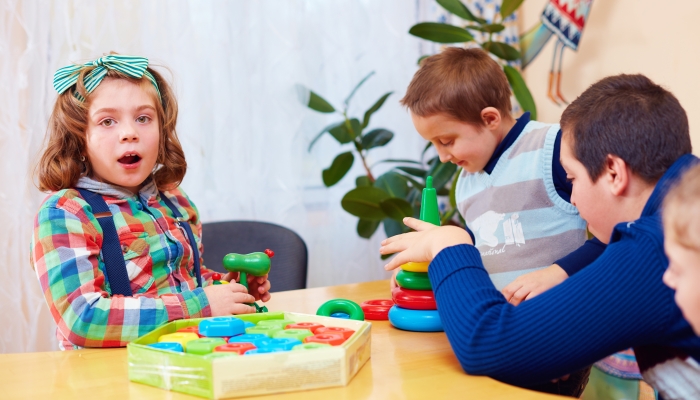
Most children, whether or not they have developmental, cognitive, or behavioral disabilities, lack the language skills to help their adults know what they need in terms of physical or behavioral support at any given moment.
A 2019 study 4 4. Yavuz, H. M., Selçuk, B., & Korkmaz, B.. Social competence in children with autism. International Journal of Developmental Disabilities . 2017;65(1), 10–19. https://doi.org/10.1080/20473869.2017.1346224 found that non-verbal communication skills had a greater impact on positive social relationships than even self-awareness or verbal communication skills for children with autism spectrum disorder (ASD).
This study suggests that focused attention to teaching children appropriate language to communicate with others and advocate for themselves, with awareness of their own and other’s nonverbal cues, is more likely to position them for social success.
Knowing how to effectively communicate and see a response to stated needs is a big part of achieving appropriate assertiveness and reaching a self-advocacy goal.
A possible IEP goal for enhancing communication skill development could include:
- The student will effectively communicate with peers and adults about their needs and interests.
Goal #5: Building Problem-Solving Skills
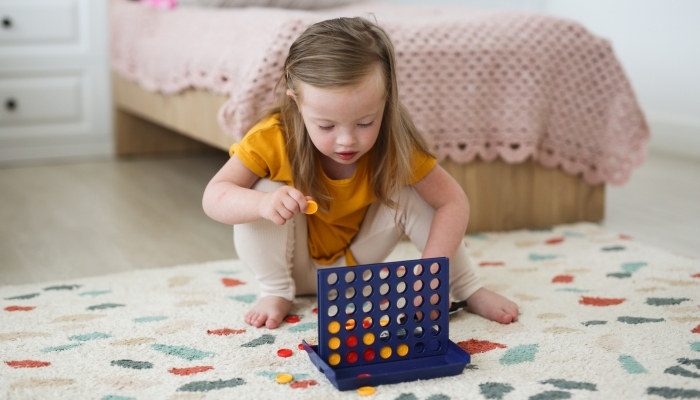
Inevitably, your child will encounter scenarios where they will need or want to use a particular accommodation or strategy, only to be met with resistance from the adults around them.
Part of being an effective self-advocate is building the necessary self-determination skills to be able to make progress towards your own goals, despite whatever obstacles are faced in the process.
Equipping your student with basic problem-solving 5 5. Milner, C.. Problem Solving: How to Teach Young Children. Nationwide Children’s Hospital . https://www.nationwidechildrens.org/family-resources-education/700childrens/2023/07/problem-solving and conflict-resolution skills 6 6. Garey, J.. Teaching Kids How to Deal With Conflict. Child Mind Institute . 2024. https://childmind.org/article/teaching-kids-how-to-deal-with-conflict builds self-efficacy abilities, which in turn promotes the goal of self-advocacy in all areas of life.
Sample IEP goals for building problem-solving skills could include:
- The student will demonstrate the ability to solve problems independently when faced with obstacles.
- The student will use words to express frustration or disagreement in 9 out of 10 conflict situations.
Teaching your child to set goals and use strategies to build self-advocacy skills positions them well to effectively communicate with other adults in their lives and increases their understanding of the world around them.
- Harris, K. (2022, July 19). Accommodations vs Modifications in Education. Modern Teacher . https://modernteacher.net/accommodations-vs-modifications
- Benefits and Examples of Student Self-Assessments. Wilson College . (2024, January 18). https://online.wilson.edu/resources/examples-of-student-self-assessment
- Using rubrics. Center for Teaching Innovation: Cornell University . (n.d.). https://teaching.cornell.edu/teaching-resources/assessment-evaluation/using-rubrics#:~:text=A%20rubric%20is%20a%20type,projects%2C%20portfolios%2C%20and%20presentations.
- Yavuz, H. M., Selçuk, B., & Korkmaz, B. (2017). Social competence in children with autism. International Journal of Developmental Disabilities , 65 (1), 10–19. https://doi.org/10.1080/20473869.2017.1346224
- Milner, C. (n.d.). Problem Solving: How to Teach Young Children. Nationwide Children’s Hospital . https://www.nationwidechildrens.org/family-resources-education/700childrens/2023/07/problem-solving
- Garey, J. (2024, March 8). Teaching Kids How to Deal With Conflict. Child Mind Institute . https://childmind.org/article/teaching-kids-how-to-deal-with-conflict
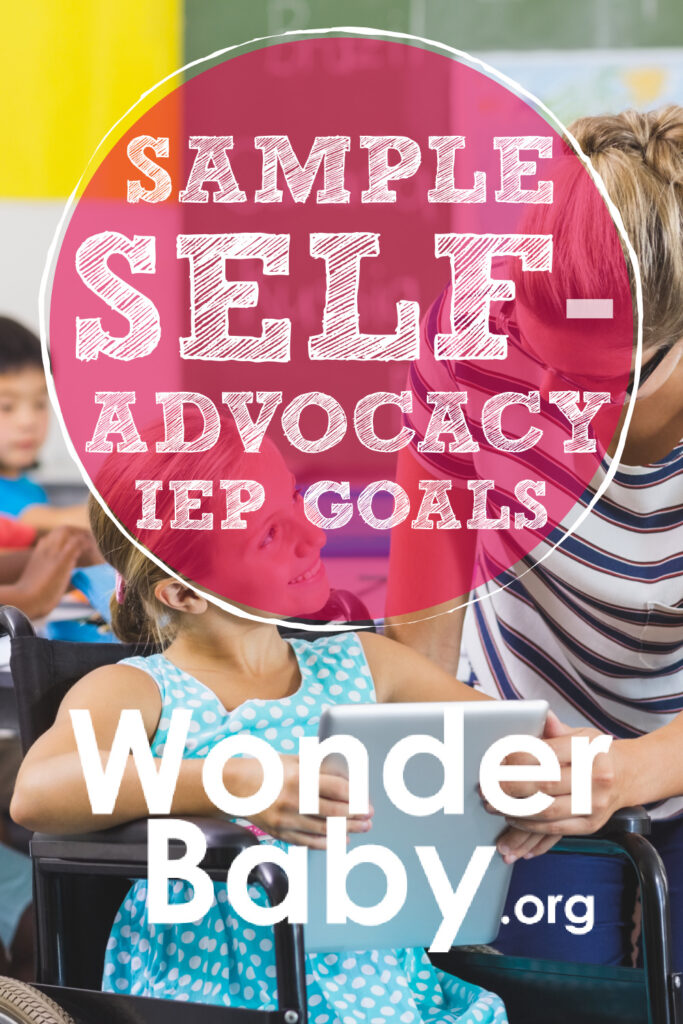
The information WonderBaby provides is not intended to be, and does not constitute, medical or other health advice or diagnosis and should not be used as such. Always consult with a qualified medical professional about your specific circumstances.
Related Posts
IEPs, Special Needs
What Is an Out-of-District Placement, and Who Needs One?
Learn all about out-of-district placement, which is ideal for a child whose individual needs are not met by their current school district.
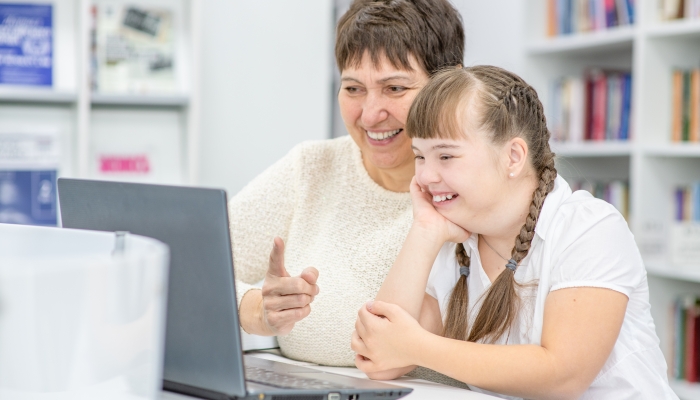

5 Ways AI Can Benefit Special Needs Students
AI in special education classrooms can help create highly personalized experiences and improve inclusivity. Read about more benefits here!
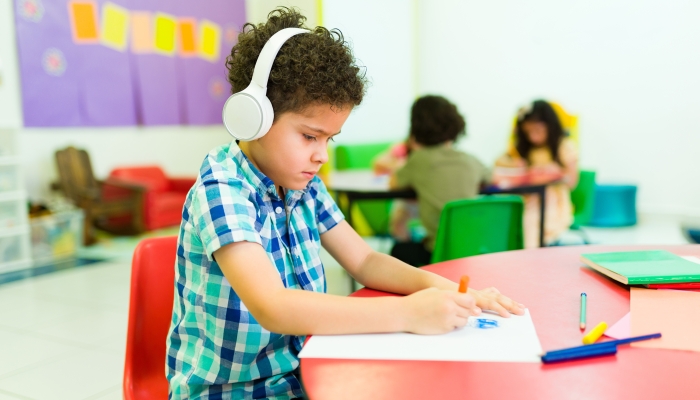
8 Sample Behavior IEP Goals
Find out how specific, measurable, and attainable behavior IEP goals help your child learn coping strategies and problem-solving skills, leading to more progress.
Now Hiring: Speech Language Pathologists! Learn more ->
Executive Functioning IEP Goals: A Complete Guide and Goal Bank
.jpg)
Executive functioning refers to a set of skills that are involved in planning, organizing, initiating, completing tasks, and regulating behavior. These skills are crucial for academic and social success, and individuals with executive functioning difficulties may struggle with daily life activities. For more in depth information on executive functioning coaching and outcomes, our Chief Clinical Officer, Dr. Jordan Wright has published a white paper that you can download it here .
IEP Goals for Executive Functioning
Individualized Education Program (IEP) goals are designed to address the specific needs of each student with a disability. When it comes to executive functioning, IEP goals may include:
- Planning and organizing : The student will be able to independently create and follow a daily schedule or task list, including prioritizing tasks and breaking them down into smaller steps.
- Initiation : The student will be able to start and complete tasks without excessive prompting or assistance from others.
- Attention and focus : The student will be able to sustain attention and focus on a task for a specified period of time, and minimize distractions.
- Time management : The student will be able to accurately estimate how long a task will take and manage their time effectively to complete it with limited prompting.
- Self-regulation : The student will be able to recognize and control their own emotional responses, impulses, and behaviors in a variety of situations.
- Problem-solving and decision-making : The student will be able to identify problems, generate and evaluate potential solutions, and make informed decisions.
These goals can be tailored to the individual needs of the student and may be adjusted over time as progress is made .
Utilize the SMART IEP Goal Model
When developing IEP goals for executive functioning skills, it is important to utilize the SMART goal model for increased success and accountability. Using this framework ensures that the goals are Specific, Measurable, Achievable, Relevant, and Time-bound. SMART goals help to clarify what the student should achieve, how progress will be measured, and by when.
To help get your Special Education/IEP team get started, we’ve put together a SMART goal bank with executive functioning IEP goals for each age group. As always, you will need to modify these goals based on the student’s individual needs and your school’s resources.
After developing your IEP goals , you and your team will want to make sure you are properly tracking and monitoring the IEP SMART goals. For more information on how to do this successfully, check out our recent blog .
Example Executive Functioning IEP Goals for Primary Students
- By the end of the school year, the student will demonstrate improved organization skills by independently creating and maintaining a daily schedule with at least 3 tasks to complete per day, with no more than 1 reminder needed per week.
- By the end of the trimester, the student will improve their time management skills by completing in-class assignments within the given time frame, with no more than 1 reminder needed per week.
- After 9 weeks, the student will improve their ability to follow multi-step directions by accurately completing classroom tasks requiring at least 2-3 steps, with no more than 1 reminder needed per week.
- By the end of the school year, the student will demonstrate improved working memory skills by recalling and following through on at least 2 multi-step directions given within a 5-minute period, with no more than 1 reminder needed per week.
- By the end of the school year, the student will improve their self-monitoring skills by checking their work for errors before turning it in, with no more than 1 reminder needed per week.
- By the end of the school year, the student will demonstrate improved attention and focus by remaining on-task for at least 5 minutes during independent work time, with no more than 1 reminder needed per week.
- By the end of the school year, the student will improve their ability to shift focus and transition between tasks by independently switching to a new task when instructed to do so, with no more than 1 reminder needed per week.
Example Executive Functioning IEP Goals for Intermediate Students
- By the end of the school year, the student will demonstrate improved planning and prioritization skills by creating and following through on a weekly schedule with at least 5 tasks to complete per week, with no more than 1 reminder needed per week.
- By the end of the school year, the] will improve their time management skills by completing in-class assignments and homework within the given time frame, with no more than 1 reminder needed per week.
- By the end of the trimester, the student will improve their ability to follow multi-step directions by accurately completing classroom tasks requiring at least 4 steps, with no more than 1 reminder needed per week.
- By the end of the school year, the student will demonstrate improved working memory skills by recalling and following through on at least 3 multi-step directions given within a 10-minute period, with no more than 1 reminder needed per week.
- By the end of the quarter, the student] will improve their self-monitoring skills by checking their work for errors and making appropriate revisions before turning it in, with no more than 1 reminder needed per week.
- By the end of the school year, the student will demonstrate improved attention and focus by remaining on-task for at least 10 minutes during independent work time, with no more than 2 reminders needed per week.
- By the end of the school year, the student will improve their decision-making skills by accurately identifying at least 3 solutions to a problem presented in class and choosing the most appropriate solution, with no more than 1 reminder needed per week.
- By the end of the school year, the student will demonstrate improved emotional regulation skills by using at least 3 appropriate coping strategies when feeling frustrated or upset in class, with no more than 1 reminder needed per week.
Example Executive Functioning IEP Goals for Middle School Students
- By the end of the school year, the student will demonstrate improved organization skills by independently creating and maintaining a weekly schedule with at least 5 tasks to complete per week, with no more than 1 reminder needed per week.
- By the end of the school year, the student will improve their time management skills by completing in-class assignments and homework within the given time frame, with no more than 1 reminder needed per week.
- By the end of the school year, the student will improve their ability to follow multi-step directions by accurately completing classroom tasks requiring at least 5 steps, with no more than 1 reminder needed per week.
- By the end of the school year, the student will demonstrate improved working memory skills by recalling and following through on at least 4 multi-step directions given within a 15-minute period, with no more than 1 reminder needed per week.
- By the end of the school year, the student will improve their self-monitoring skills by checking their work for errors and making appropriate revisions before turning it in, with no more than 2 reminders needed per week.
- By the end of the trimester, the student will demonstrate improved attention and focus by remaining on-task for at least 15 minutes during independent work time, with no more than 2 reminders needed per week.
- By the end of the school year, the student will improve their decision-making skills by accurately identifying at least 4 solutions to a problem presented in class and choosing the most appropriate solution, with no more than 1 reminder needed per week.
Example Executive Functioning IEP Goals for High School Students
- By the end of the school year, the student will demonstrate improved organization skills by independently creating and maintaining a daily and weekly schedule with at least 5 tasks to complete per day and 10 tasks per week, with no more than 1 reminder needed per week.
- By the end of the school year, the student will improve their ability to follow multi-step directions by accurately completing classroom tasks requiring at least 6 steps, with no more than 1 reminder needed per week.
- By the end of the school year, the student will demonstrate improved working memory skills by recalling and following through on at least 5 multi-step directions given within a 20-minute period, with no more than 1 reminder needed per week.
- By the end of the school year, the student will demonstrate improved attention and focus by remaining on-task for at least 20 minutes during independent work time, with no more than 1 reminder needed per week.
- By the end of the school year, the student will improve their decision-making skills by accurately identifying at least 5 solutions to a problem presented in class and choosing the most appropriate solution, with no more than 1 reminder needed per week.
- By the end of the school year, the student will demonstrate improved emotional regulation skills by using at least 4 appropriate coping strategies when feeling frustrated or upset in class, with no more than 1 reminder needed per week.
Want more? Subscribe for access to all free resources
79+ districts thriving with parallel.

Kelsey Breen
Special Education Coordinator, Illinois Valley Central School District

The professionals you need, the flexibility you want
With live-online services we are able to find related service professionals that will not compete against your ability to hire individuals in-district. We can reach IEP and 504 students from multiple sites, and offer flexible scheduling and pricing options.

Related articles

Navigating Successful IEP Transitions: Planning for Students with Disabilities
.jpg)
How to Create SMART Goals for Effective IEPs

SLP IEP Goal Bank: 80 Customizable IEP Goals for Speech-Language Pathologists
Empowering School Districts with World-Class Providers, Fast

Contact & Support
Follow on Facebook
Connect on LinkedIn
Follow on Instragram
Subscribe on Youtube
All clinical services are provided by licensed physicians and clinicians practicing within independently owned and operated professional practices. For patients in New York and Connecticut, this is known as “Parallel Behavioral Health, P.C.” Parallel Learning, Inc. does not itself provide any physician, behavioral health professional, or other healthcare provider services.

- Teachers Collaborative @ TeachTasticIEP
- Nov 29, 2023
7 Proven Word Problem IEP Goals to Boost Math Skills in Special Education
Do you ever wonder how we can better support students with disabilities in developing their math skills? The secret lies in individualized education programs (IEPs) and word problem IEP goals specifically designed to empower these students. By setting tailored, achievable goals and implementing effective strategies, we can help special education students unlock their potential and thrive in the world of mathematics.
In this blog post, we’ll explore the importance of word problem skills, the components of effective word problem IEP goals, various teaching strategies, sample goals for different math operations, and how to adapt these goals for students of different age groups and reading abilities. So, let’s dive into the world of IEP goals and word problems to help students succeed in math!
Key Takeaways
Create SMART goals with measurable criteria to boost math skills in special ed
Use visual supports, breaking down problems into smaller steps & reinforcing keywords/vocabulary for effective teaching of word problems
Monitor progress and adjust IEP goals regularly for best support of student growth
Developing IEP Goals for Word Problems

Individualized Education Programs (IEPs) are instrumental in addressing the distinct needs of students with disabilities. These customized plans set specific goals and provide accommodations that enable students to improve their math skills and independently determine solutions to problems. Creating successful IEP goals for word problems involves strategies like one to one correspondence to help students comprehend the relationship between numbers and items in the problems.
Setting clear goals boosts a student’s capacity to identify key information, apply accurate mathematical operations, and refine problem-solving skills. Let’s look closer at the importance of word problem skills and the components of effective IEP goals.
Importance of Word Problem Skills
Proficient word problem-solving skills are pivotal for success in academics, professional life, and practical applications. Teaching students to solve word problems effectively aids in developing their critical thinking and problem-solving skills, beneficial in diverse life aspects. Furthermore, working on word problems helps students strengthen their executive functioning skills, such as working memory and cognitive flexibility.
To help special education students grasp keyword vocabulary, teachers can clearly explain the words and their meanings, as well as provide practical examples of word problems that involve these keywords. This focused approach can help students achieve their math goals and improve their overall understanding of word problems.
Components of Effective IEP Goals
An effective IEP goal should be SMART:
Specific: Delineate the desired outcome, success criteria, and completion timeframe
Measurable: Enable effective planning, monitoring, and evaluation of the student’s progress
Achievable: Realistic and attainable for the student
Relevant: Address the student’s specific needs and areas of growth
Time-bound: Have a clear completion timeframe
This clarity and focus enable us to effectively plan, monitor, and evaluate the student’s progress.
Assessing progress is integral to the success of an IEP goal. A student’s performance can be measured quarterly, allowing the IEP team to make adjustments and provide additional support as needed. Setting measurable goals heightens accountability and student engagement, fostering overall academic success.
Strategies for Teaching Word Problems in Special Education

Various teaching strategies can support special education students in understanding and solving word problems. These strategies include using visual supports, breaking down problems into smaller steps, and reinforcing keywords and vocabulary. Implementing these techniques helps provide the requisite support for students to excel in their mathematical word problem skills.
Let’s dive deeper into these strategies and explore how they can be effectively applied in the classroom.
Visual Supports
Visual aids like graphic organizers and manipulatives can considerably augment a student’s grasp of word problems. Number lines, Cuisenaire rods, and place value charts are just a few examples of math manipulatives that can be used with graphic organizers to help students visualize and solve word problems.
Visual supports can also be particularly helpful for students who struggle with reading comprehension or have difficulty processing verbal information. Diagrams, charts, or pictures can make the problem more concrete and easier to understand. They can also help students organize information and identify key details in the problem, increasing engagement and motivation.
Breaking Down Problems into Smaller Steps
Segmenting word problems into smaller steps can enhance comprehension, reduce cognitive load, refine problem-solving skills, and foster confidence for students in special education. To break down word problems into smaller steps, it’s crucial to visualize the problem, break it into smaller components, and then guide students through each step.
Using a variety of teaching techniques can prove effective in helping special education students break down word problems. Some techniques to consider are:
Solving word problems regularly
Teaching problem-solving routines
Visualizing or modeling the problem
Providing clear and concise models
By incorporating these techniques into your teaching, you can support special education students in understanding and solving word problems more effectively.
Reinforcing Keywords and Vocabulary
Imparting and reinforcing keyword vocabulary is vital in aiding students to comprehend word problems better. By recognizing key words and phrases that indicate mathematical operations and relationships, students can apply the right problem-solving strategies and improve their comprehension of word problems.
Some effective techniques for reinforcing keywords and vocabulary in special education include:
Using keyword vocabulary
Training students to paraphrase relevant information
The keyword method
Word walls or graphic organizers
Keep in mind that solely relying on keywords could limit conceptual understanding, so it’s essential to incorporate other teaching strategies as well.
Sample IEP Goals for Different Math Operations

To enhance support for special education students in solving word problems, we should consider sample IEP goals for different mathematical operations, like:
Addition Word Problem IEP Goal
A sample goal for solving one-step addition word problems could be: “Given a one-step addition word problem (single digit, double-digit, etc.), the student will independently solve the problem with 80% accuracy on 4 out of 5 trials.” For multi step word problem scenarios, you might aim for: “Given a multi-step addition word problem, the student will independently solve the problem with 75% accuracy on 4 out of 5 trials.”
These goals encourage students to develop a deeper understanding of the addition process while also addressing their individual needs in solving word problems. By setting specific accuracy rates and timeframes, we can better track progress and make necessary adjustments to the goals.
Example Addition Word Problem IEP Goals
1.OA.A.1: Use addition and subtraction within 20 to solve word problems involving situations of adding to, taking from, putting together, taking apart, and comparing, with unknowns in all positions, e.g., by using objects, drawings, and equations with a symbol for the unknown number to represent the problem. This goal covers the following objectives
Solve addition word problems with pictures
Scaffolded addition word problems with sums up to 10
Solve addition word problems with sums up to 20
Write an addition sentence that fits the story (two-digit numbers)
Grade Level Standard: 1.OA.A.2: Solve word problems that call for addition of three whole numbers whose sum is less than or equal to 20, e.g., by using objects, drawings, and equations with a symbol for the unknown number to represent the problem. This goal covers the following objectives
Add three numbers - word problems
Solve addition facts - sums up to 20
Solve addition word problems - sums up to 10
Subtraction Word Problem IEP Goal
A sample goal for solving subtraction word problems might be: “Given a subtraction word problem, the student will independently solve the problem using appropriate subtraction strategies with 80% accuracy, in 4 out of 5 opportunities, by the end of the IEP period.” This goal focuses on the student’s ability to apply subtraction strategies effectively and accurately in solving word problems.
Setting a specific accuracy rate and timeframe allows us to monitor the student’s progress and make any necessary adjustments to the goal. Remember to keep the goal SMART:
Example Subtraction Word Problem IEP Goals 2.OA.A: Represent and solve problems involving addition and subtraction.
2.OA.A.1: Use addition and subtraction within 100 to solve one- and two-step word problems involving situations of adding to, taking from, putting together, taking apart, and comparing with unknowns in all positions, e.g., by using drawings and equations with a symbol for the unknown number to represent the problem. This goal covers the following objectives
Solve two-step addition and subtraction word problems - up to 100
Add and subtract word problems - up to 100
Add and subtract word problems - up to 20
Add three numbers up to two digits each: word problems
Multiplication and Division Word Problem IEP Goal
For multiplication word problems, a sample goal could be: “Given a word problem that requires multiplication, the student will solve the problem and find the product with 80% accuracy on 4 out of 5 trials.”
As for division word problems, a goal might look like this: “Given a division word problem, the student will independently solve the problem using appropriate division strategies with 80% accuracy, in 4 out of 5 opportunities, by the end of the IEP period.”
These goals focus on the student’s ability to apply multiplication and division strategies effectively and accurately in solving word problems. By setting specific accuracy rates and timeframes, we can track progress and make any necessary adjustments to the goals.
Example Multiplication and Division Word Problem IEP Goals
3.OA.A.3: Use multiplication and division within 100 to solve word problems in situations involving equal groups, arrays, and measurement quantities, e.g., by using drawings and equations with a symbol for the unknown number to represent the problem. This goal covers the following objectives
Write variable equations to represent word problems: multiplication and division only
Multiplication and division word problems
Division word problems
Multiplication word problems
These goals can serve as a guide for writing more specific individualized IEP goals that cater to the unique needs of each student.
Bear in mind, personalizing the IEP goal to cater to each special education student’s individual needs is imperative. With that in mind, let’s explore some sample goals for each math operation.
Adapting Word Problem IEP Goals for Different Age Groups

As students advance in their education, their IEP goals for word problems should adapt to accommodate their evolving needs and abilities. In this section, we’ll discuss how to adapt IEP goals for different age groups, such as elementary, middle, and high school students.
Taking into account the distinct needs of students at each educational stage, we can formulate effective and age-appropriate IEP goals that bolster their growth and development in mathematical word problem skills.
Elementary School
For elementary school students, IEP goals for word problems should focus on building a solid foundation in math skills and problem-solving strategies. Some ways to adapt IEP word problems for this age group include:
Simplifying the language and concepts
Using visual aids and manipulatives
Providing step-by-step guidance
Incorporating real-life examples and familiar contexts
These strategies can help students solve word problems better and enhance their understanding.
By setting age-appropriate goals and providing the necessary support, we can help elementary school students develop a strong foundation in word problem skills, setting them up for success as they progress through their education.
Middle School
Middle school students need IEP goals that build on their elementary math skills and delve deeper into more advanced concepts. To adapt IEP goals for this age group, consider:
Increasing the complexity of word problems
Incorporating higher-order thinking skills
Setting up multi-step problems
Providing scaffolding and support
By challenging middle school students with more complex word problems and offering various problem-solving strategies, we can help them develop the skills necessary for success in high school and beyond.
High School
High school students require IEP goals that prepare them for post-secondary education and employment. These goals should focus on analyzing and interpreting data, applying advanced algebraic concepts, and solving multi-step equations. To adapt IEP goals for high school students, give them a clear and concise model of how to solve word problems and ensure ample practice and reinforcement.
By tailoring IEP goals to the unique needs and abilities of high school students, we can help them develop the advanced problem-solving skills necessary for success in their future endeavors.
Monitoring Progress and Adjusting IEP Goals

Tracking progress and modifying IEP goals is imperative to ensure students’ continuous growth and development in their math word problem skills. By regularly assessing student progress, we can make data-driven decisions about instruction and interventions, pinpoint areas of strength and improvement, and make necessary adjustments to IEP goals.
In the next two subsections, we will explore methods for measuring student progress and adjusting IEP goals based on their evolving needs.
Measuring Progress
Tracking student progress toward IEP goals can be accomplished through different methods like:
Direct observation
Assessments
IEP Goal Data Sheets
We should check in on progress towards IEP goals at least every two weeks, but it could be more or less often depending on the goal.
Data analysis plays a crucial role in tracking IEP goals. It helps us:
Identify areas of strength and improvement
Make informed decisions about instruction and interventions
Provide objective evidence of a student’s progress
Adjusting Goals
Modifying IEP goals is vital to ensure continuous progress in students’ word problem skills. If a student isn’t making the appropriate progress or is losing skills they previously had, it may be time to adjust their IEP goal. We should review the IEP annually to ensure that the goals are still suitable for the student.
When adjusting IEP goals for word problems, it’s important to consider the student’s individual needs and progress, as well as any specific challenges they may be facing. By regularly monitoring progress and making necessary adjustments, we can provide the best possible support for our students’ growth in math word problem skills.
In this blog post, we explored the importance of setting IEP goals for word problems to help special education students develop their math skills. We discussed various teaching strategies, such as visual supports, breaking down problems into smaller steps, and reinforcing keyword vocabulary. We also provided sample IEP goals for different math operations and tips for adapting goals to different age groups.
Empowering special education students with the right tools and support can make all the difference in their success in mathematics. By setting individualized, achievable goals and implementing effective strategies, we can help them unlock their potential and thrive in the world of math word problems.
Frequently Asked Questions
What are the iep goals examples.
IEP goals examples range from improving reading comprehension and fluency to developing self-regulation, communication and organizational skills. They may also include honing math skills, fine motor control, social skills and college/career exploration.
What are the IEP goals for letter word identification?
The IEP goal for letter word identification is that the student will correctly identify and verbally name 3 lowercase letters during each session with 80% accuracy across three consecutive data collection points.
What are the IEP writing goals for grammar?
Writing goals for grammar should include complete sentences with proper syntax, sentence variety, subject-verb agreement, punctuation, and capitalization.
What is the significance of IEP goals for word problems?
IEP goals for word problems provide special education students with objectives and accommodations to help them learn math independently and develop their problem-solving skills.
What are some effective strategies for teaching word problems in special education?
Using visual supports, breaking down word problems into smaller steps, and reinforcing keyword vocabulary are effective strategies for teaching word problems in special education.
Related Posts
IEP Goal Bank - Reading Comprehension (Mid)
IEP Goal Bank - Decoding and Word Recognition (readiness)
IEP Goal Bank - Reading Comprehension (readiness)
Related Products

Center - Represent Integers on Number Lines

Write the Room - Round to the Nearest Hundred

Write the Room - Represent Integers on Number Lines

Represent Integers on Number Lines Worksheet Pack

Turn Words Into Addition Sentences | Lesson Plan and Worksheet Pack

Match Addition Sentences to Models | Lesson Plan and Worksheet Pack

Addition Sums up to 10 | Lesson Plan and Worksheet Pack

Adding with 0 | Lesson Plan and Worksheet Pack

Match Models to Addition Sentences | Lesson Plan and Worksheet Pack

Addition Models | Lesson Plan and Worksheet Pack

Classify and Sort by Shapes | Lesson Plan and Worksheet Pack

Representing Numbers with Pictures up to 3 | Lesson Plan and Worksheet Pack

Spelling Lesson Pack for First Grade "Phonics and Sight Word Based" 31 Weeks

Spelling Lesson Pack for Kindergarten "Phonics and Sight Word Based" 22 Weeks

St. Patrick's Day Creative Writing Worksheets for Special Education

Bunny's Eggcellent Addition Challenge | Addition to 10 Fluency
IEP Behavior Goals
Are you struggling with effective behavior goals for your child’s Individualized Education Program (IEP)?
Don’t worry. You’re not alone. Setting the correct goals can be challenging, mainly when dealing with behaviors that might prevent your child from succeeding in school. But don’t give up! We’ll get into the details of IEP behavior goals in this blog article, including how to set them, monitor progress, and ensure they’re relevant and doable for your child .
Whether you’re a parent, teacher, or another member of the educational community, this post is filled with helpful advice and insights to aid you in developing a strategy for success .
So let’s get started!
About IEP Behavior Goals
An Individualized Education Program (IEP) document outlines the specific educational and related services a child with a disability will receive . It is developed jointly by the parents, teachers, and other academic experts of the student and intended to fit their particular needs.
A crucial component of an IEP is the inclusion of behavior goals , which are focused interventions intended to deal with any problematic behaviors that might impede the child’s academic or social development.
The ultimate purpose of any IEP behavior goals, which can take many forms, is to assist the child in acquiring more appropriate and positive behaviors to help them succeed in school and beyond. It can entail developing the child’s social abilities, self-control, and other abilities to help them perform better in school and other activities.
Though it might be a complicated process, setting behavior objectives is crucial. You may assist your child in making substantial progress in their academic and personal development by identifying particular behaviors that need to be addressed and conducting a Functional Behavior Assessment .
We’ll look more closely at how to write concrete IEP behavior goals for your child’s IEP in the section after this one. One key aspect of the process will be developing a Behavior Intervention Plan .
What are the Behavior Goals for an IEP?
Certain behaviors, which are the focus of IEP behavior goals, may negatively affect a child’s learning or social development. These objectives are typically part of a larger plan to assist a child’s overall academic and personal growth in their IEP.
Various behaviors, including social skills , self-regulation, communication, and other areas that might be the subject of IEP behavior goals , may impact a child’s capacity to participate in school and other activities.
For instance , a child who struggles to manage their emotions can have a behavior objective relating to developing coping mechanisms. Another child who struggles in class with concentration can have a goal to sharpen their focus and concentration.
According to each child’s particular needs and difficulties, the specific behaviors targeted by IEP behavior goals will vary. With these interventions, the school will assist the child in acquiring more good and appropriate behaviors that will help them succeed in school and beyond. This process is often supported by various educational resources , which offer additional guidelines and tools for creating effective IEPs.
What are Behavioral Goals Examples?
Here are some examples of IEP behavioral goals that an IEP may include:
- Increasing social interaction : A child struggling with peer interaction might aim to enhance their social abilities. Working on skills like a conversation starter, turn-taking, and sharing with others may be a part of this. You may find it helpful to use resources like the American Psychological Association’s guide on children’s social development.
- Improving self-regulation : If a child struggles with self-regulation, one of their goals is possibly to become more adept at controlling their emotions and behaviors. It might be acquiring coping mechanisms for dealing with challenging emotions, creating a strategy for managing annoyance, or knowing when to take breaks.
- Increasing communication skills : A child who struggles with communication might want to develop expressive or receptive language skills. Some examples are working on things like asking and responding to inquiries, expressing needs and wishes verbally, and comprehending and acting upon instructions.
- Improving focus and attention : Increasing focus and concentration may be a goal for a child who struggles in class to pay attention. It may entail methods like making a visual timetable, taking pauses, or utilizing a fidget toy to assist them in staying focused.
- Reducing aggressive behavior : A child who engages in aggressive conduct would want to lessen the frequency and severity of such behavior. It could entail finding other ways to express displeasure or rage, developing a strategy for addressing conflicts or learning to control your emotions when you’re unhappy.
These are just a few examples of the types of IEP behavior goals the school may include in an IEP. It’s important to note that each child’s goals will be unique and tailored to their specific needs and challenges .
What are Some Examples of IEP Goals?
Here are some examples of IEP behavior goals that the school may include in a child’s IEP:
- Academic goals focus on enhancing the child’s intellectual abilities in reading, writing, and math. For instance, a child who has trouble understanding what they read can set a goal to comprehend better and analyze what they read.
- Behavioral goals address actions hindering the child’s academic or social growth. For instance, a youngster struggling to manage their emotions can set a goal for developing coping mechanisms.
- Physical goals focus on enhancing the child’s physical abilities, such as gross motor coordination or fine motor control. For instance, a child with cerebral palsy might want to work on developing their pencil-writing skills.
- Social goals : These goals focus on enhancing the child’s social skills, which include cooperating with classmates, waiting their turn, and adhering to norms. For instance, a child who struggles to make friends can set a goal to develop their capacity for striking up talks and forming bonds with people.
- Communication goals focus on enhancing the child’s communication abilities, such as expressive language (using words to convey needs or wishes) or receptive language (understanding and following directions). For instance, a child with trouble speaking clearly can set a goal to improve their articulation.
IEP goals can take many forms, and the specific goals included in a child’s IEP will depend on their unique needs and challenges . It’s important to note that IEP goals should be measurable, achievable, and relevant to the child’s overall development.

How Do You Track Behavioral IEP Goals?
Tracking behavioral IEP goals is integral to addressing challenging behaviors in children with disabilities.
There are several different approaches you can take to track progress on IEP behavior goals, including:
- Observations : Observations are a helpful tool for monitoring behavioral goal progress. It may entail having a teacher or other educational specialist keep track of the child’s conduct in various contexts (such as the classroom and the playground) and note any alterations or advancements over time.
- Self-monitoring : Another option is to let the child monitor their actions. It may entail marking each time they successfully execute a behavior on a chart or other visual aid and utilizing a tally or other mechanism to monitor progress.
- Data collection : It can be helpful to gather information on the child’s behavior to monitor progress over time. It may include the child’s reactions to various interventions or techniques or entail utilizing a spreadsheet or other tool to record the frequency or intensity of specific behaviors.
- Check-ins with the child : Collecting data on the child’s behavior can help track development over time. It could involve observing how the child responds to different therapies or strategies or using a spreadsheet or another tool to track the frequency or severity of particular behaviors.
Data collection on the child’s behavior can help trace their development. It could be tracking the frequency or seriousness of specific behaviors using a spreadsheet or another tool or seeing how the child responds to various therapies or techniques.
Non-Compliance IEP Goals
Non-compliance refers to a child’s refusal or inability to follow the rules, instructions, or requests . It can be a challenging behavior to address, especially in the context of an Individualized Education Program (IEP).
Non-compliance may be listed as a goal in a child’s IEP if determined as a problem behavior for that kid. Depending on the underlying reasons for the non-compliance and the requirements and difficulties of the particular kid, the specific goals and solutions included in the IEP behavior goals will vary.
Here are some examples of IEP behavior goals related to non-compliance :
- Increasing compliance with rules and instructions : A child who struggles to comply with regulations or instructions may have a goal to become more compliant. It could entail employing techniques like social storytelling, visual supports, or positive reinforcement to assist the child in comprehending the value of adhering to rules and directions.
- Improving communication skills : A child with trouble expressing their needs or wishes could also have difficulty following directions. In this situation, the IEP can include a goal for enhancing communication abilities. Working on expressive language, receptive language, or other communication skills may be required.
- Developing problem-solving skills : A goal focused on improving problem-solving abilities may be helpful for a child who has trouble following requests or instructions. Helping the child learn to recognize and communicate their needs, create coping mechanisms for challenging circumstances, or engage in negotiation to reach amicable agreements with others falls under this category.
- Reducing negative consequences : If a child exhibits noncompliant behavior, they may suffer unfavorable outcomes like reprimands, loss of privileges, or other types of punishment. Creating tactics for dealing with non-compliance more encouragingly and constructively may be a part of an IEP goal related to reducing negative consequences.
By setting clear, achievable goals and implementing targeted interventions, you can help your child improve their compliance and achieve their full potential.

Jennifer Hanson is a dedicated and seasoned writer specializing in the field of special education. With a passion for advocating for the rights and needs of children with diverse learning abilities, Jennifer uses her pen to educate, inspire, and empower both educators and parents alike.
Related Posts
A comprehensive guide to behavior intervention plans (bip) in special education, esy special education.

- Meet Our Team
- Discover The LSA Difference
- Coaching Process
- Core Values
- What is Executive Functioning?
- Understanding the EF Ripple Effect
- For Daily Life
- ND-Friendly Tools
- Executive Functioning Assessment
- Executive Functioning Meal Plan
- Executive Functioning 101 Resource Hub
- Executive Functioning IEP Goal Resource Hub
- How To Make Stuff More EF Friendly
12 Task Initiation IEP Goals for Real Life
Written by:
Rebekah Pierce
Filed under: Task Initiation , Executive Functioning , IEPs
Published: March 20, 2022
Last Reviewed: February 26, 2024
READING TIME: ~ minutes
This article is designed to be utilized with the utmost professional integrity and ethical consideration. It is imperative to acknowledge that directly copying and pasting example goals into student’s IEPs from any external source, including ours, undermines the individualized nature of IEP planning and does not serve the best interests of students.
This resource aims to inspire the development of IEP goals that address executive functioning needs, not a substitute for the detailed, student-centered IEP goal setting process. Educators and IEP teams are urged to use this as a tool for ideation, basing final goals on student assessments and collaborative IEP team insights.
We’re all busy – and we’re demanding more from our children and teens than ever before. It’s no wonder that some kids struggle with task initiation as a basic executive functioning skill.
Task initiation can be a difficult skill to master, especially for kids who struggle with ADHD or executive function disorders. Here are a few tips for writing IEP goals to help your child get started on tasks more easily.
What is Task Initiation?
Task initiation refers to the ability of a child (or adult) to initiate and start a task independently – in other words, without being prodded or nagged.
It can encompass a wide variety of skills, including responding to instructions, generating ideas, and solving problems.
As a core executive functioning skill, it’s one that is problematic for the vast majority of kids with autism spectrum disorder and other unique learning backgrounds. You might suspect that your child is struggling with task initiation if he or she:
- Needs multiple reminders to start and complete a task
- Puts off chores and homework until it’s the absolute last minute
- Needs help often, even for basic tasks
- Engages in challenging behavior as a method of escaping tasks that need to be done
When a child struggles with task initiation, it’s common for him to become accustomed to adults jumping in to help. While this works well in the short-term, in the long term it is problematic because he can’t start and finish a task on his own.
Sample IEP Goals for Task Initiation
Teaching task initiation is essential if you want to create a self-sufficient teen and adult. It needs to be taught directly and through positive reinforcements. It should be one of the first executive functioning skills to focus on because it goes hand-in-hand with other skills, like planning, emotional regulation, organization, and time management.
Without mastering task initiation skills, it will be challenging – if not impossible – to teach other skills.
Adaptive Goals
- By the end of the IEP period, when given instructions to start a familiar task along with appropriate visual supports, the student will begin the task within 15 minutes, 90% of the time, according to teacher observation.
- By the end of the IEP period, when given up to five different tasks, the student will identify the proper order to complete the tasks and begin each one within two minutes of completing the last, 80% of the time, according to teacher observation.
Social Goals
- By the end of the school year, when given appropriate visual support or adult prompting, the student will begin a non-preferred task within 60 seconds without demonstrating challenging behavior, 100% of the time, according to teacher observation.
- By the end of the IEP period, when given appropriate adult prompting, the student will leave a desired activity to complete a non-preferred task within one minute without demonstrating challenging behavior or refusal, 100% of the time, according to teacher observation.
- By the end of the school year, when the student has difficulty initiating a task, he will identify the problem and find the right resource for obtaining help without engaging in challenging behavior, 100% of the time, according to teacher observation.
Reading Goals
- By the end of the school year, when given a reading assignment, the student will evaluate whether it is difficult and ask for help or other resources if necessary 100% of the time, according to teacher observation.
- By the end of the IEP period, when given a reading assignment, the student will use a weekly calendar to write upcoming due dates with 90% accuracy as evidenced by weekly teacher checks.
- By the end of the school year, when solving math word problems, the student will respond to a countdown timer to begin the task, 90% of the time, according to teacher observation.
- By the end of the IEP period, when solving math word problems, the students will independently identify the starting point for an unfamiliar problem 90% of the time, according to teacher observation.
- By the end of the school year, the child will know when to ask for help and when to keep trying to solve a problem independently, 90% of the time, according to teacher and student observation.
Writing Goals
- By the end of the school year, when given a written assignment, the student will identify and gather the material necessary to complete the task 100% of the time, according to teacher observation.
- By the end of the IEP period, when given a complex writing task or project, the student will organize the task on paper, including the materials and steps needed to accomplish the task, and complete it within a reasonable time frame 100% of the time, according to teacher observation.
Tips on Setting Goals for Task Initiation
Here are a few simple tips to follow as you set goals for task initiation.
Focus on Task Analysis
One of the most effective ways to set and achieve goals related to task initiation is to conduct task analysis. This is simply the act of breaking a larger skill down into multiple subtasks. You’ll teach these subtasks as individual goals instead of trying to accomplish one massive, goliath goal. This can be overwhelming.
Task analysis can also help build autonomy and self-esteem . As your child accomplishes each goal, he’ll be progressing toward the larger goal and improving his confidence in himself along the way.
An example is in using a Topic Selector worksheet like what you’ll find in the Real Life Executive Functioning Workbook (coupon code LSA20 for 20% off at checkout) to plan out key ideas for an assignment or project. This can help break a project down into smaller steps so that it gets started (and gets done) on time.
Start With Preferred Activities
When you’re setting goals for task initiation, try to start with activities that the child enjoys doing first. If a child has a long history of not responding well to adult instructions, it can cause behavioral habits that are hard to break – and challenging to deal with.
Beginning with preferred activities will associate the process of task initiation with fun – and help a child stay motivated to continue making progress in the future.
Provide Positive Reinforcement
Task initiation is an executive functioning skill that’s often closely connected to challenging behaviors. Because of this, providing positive reinforcement is essential to help give your child the boost he needs to work hard.
Of course, you also need to teach your child his own strategies for staying motivated, too. The Pep Talk worksheet found in the Real Life Executive Functioning Workbook can help.
Use Visuals
You’ll notice that some of the sample IEP goals we told you about above mention the use of visual supports. Visual supports are technically adult assistance – so you might be wondering why you’re still providing assistance if the goal is to initiate tasks independently.
However, using visual supports like checklists, calendars, flashcards (the Real Life Executive Functioning Workbook has some helpful templates!) and apps can help a child become better at initiating tasks because they include their own built-in prompts.
Although these might be considered crutches to help a student meet his goals, they are nevertheless crutches that can be used forever – you won’t have to “wean” the child off them. After All, there’s a good chance that you use a calendar as a highly functioning adult, right?
Set Time Related Goals
A pitfall that many teachers and parents run into when setting IEP goals related to task initiation is that they make them all about the task – and don’t pay any mind to the time involved. The goal here needs to be not only starting tasks independently but also doing so (and completing those tasks) within a reasonable time frame.
Use warnings to move between tasks and get your child into the habit of transitioning between tasks on his own. The Countdown Exercise in the Real Life Executive Functioning Workbook can help them do that.
How to Address Each Goal
Setting goals for learners of all abilities can be a challenge – but the more specific and measurable, the better.
Write down as many ideas about what your child needs to accomplish.
The Executive Functioning Assessment can help give you a baseline of where your child is struggling – and what can be done to improve. It will give you clear strategies that you can use to come up with a solution to help your child succeed. You’ll be able to address each goal separately in a clear, concise, and actionable plan.
It’s not just for teachers but can instead be used by parents, administrators, paraprofessionals, or even the student himself! It’s easy to integrate into your current IEP writing process and is loaded with activities that you can add seamlessly into your daily routine.
The Next “Task” to Initiate
The takeaway is this- when writing IEP goals for task initiation , be sure to consider all of the factors that might impact your student’s ability to get started on a task. Consider taking the Executive Functioning Assessment with your child and be sure to download the Real Life Executive Functioning Workbook as your first steps toward writing meaningful IEP goals for task initiation.
These tips will help you create meaningful and achievable goals that can make a real difference in your child’s academic success.
Looking For More Executive Functioning IEP Goal Ideas?
Visit our EF IEP Goal Resource Hub or check out our other skill-specific IEP goal articles:
- 8 Impulse Control IEP Goals
- 8 Attentional Control IEP Goals
- 8 Self-Monitoring IEP Goals
- 10 Problem Solving IEP Goals
- 10 Working Memory IEP Goals
- 9 Emotional Control IEP Goals
- 7 Cognitive Flexibility IEP Goals
- 10 Organization IEP Goals
- 12 Task Initiation IEP Goals
- 10 Time Management IEP Goals
- 15 Planning IEP Goals
Further Reading
- Amy Sippl: Executive Functioning Skills 101: The Basics of Task Initiation
- Amy Sippl: Task Initiation Tools to Support Your Adolescent
About The Author
Rebekah pierce.
Rebekah is a New York writer and teacher who specializes in writing in the education, gardening, health, and natural food niches. In addition to teaching and writing, she also owns a farm and is the author of the blog J&R Pierce Family Farm .
Related Posts
How teaching executive functioning skills can reduce challenging behaviors, how to make studying executive function friendly, understanding the adhd iceberg: a comprehensive guide for parents and educators, 10 powerful tools for jumpstarting executive functioning in 2023, teaching the ideal problem-solving method to diverse learners, every parent’s guide to decision fatigue (part 1).
Life Skills Advocate is a participant in the Amazon Services LLC Associates Program, an affiliate advertising program designed to provide a means for sites to earn advertising fees by advertising and linking to Amazon.com. Some of the links in this post may be Amazon.com affiliate links, which means if you make a purchase, Life Skills Advocate will earn a commission. However, we only promote products we actually use or those which have been vetted by the greater community of families and professionals who support individuals with diverse learning needs.
Session expired
Please log in again. The login page will open in a new tab. After logging in you can close it and return to this page.
Creating IEP Goals for Decision Making Skills and Goal Setting
- David Graham Farnsworth
- Categories : Special education law ID ea, ieps, 504s, cses & planning
- Tags : Special ed information for teachers & parents
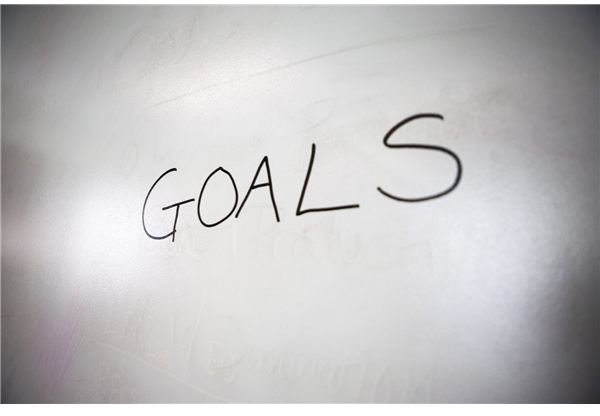
Life Control
Creating IEP goals for decision-making skills allows students the right and ability to maintain control over and direction of their own
lives. Goals let the learner make decisions and choices about all things that have a bearing upon his or her daily life. Underlying these decision-making goals is the special education student’s capacity to realize his or her own challenges and strengths – what works best.
Action plans and time lines remain important to attain these goals. It is imperative that the IEP team stay cognizant that goals centered on decision-making do not involve merely one skill. Self-determination, choice-making, problem-solving, self-awareness, communication, self-regulation, goal-setting, self-advocacy and leadership all comprise the formation of decision-making skills that lead to the promotion of effective well-being. With the attainment of appropriate decision-making skills, student performance increases with the likelihood to attain positive post-school outcomes.
Foremost, students should participate in the process of creating IEP goals to help make choices concerning their needs, likes and accommodations. A student’s active attendance at the IEP meetings and realization of his or her rights remain paramount for success. Teachers and all IEP team members need to support a student’s participation to develop the most appropriate goals. Goal setting always involves a student-centered approach toward planning for both the immediate and long-term future. When the IEP team aids the student in making wise choices and respects his or her value in society, goals are more readily achieved. The student is more apt to attain IEP decision-making goals with the realization that even small successes are significant. When determining goals always remember that a child has a home life and a school life. Negotiate.
Decision-Making and Problem-Solving
Be sure you realize the difference between decision-making skills and problem-solving skills when coming up with a student’s goals. Problem-solving involves a set of actions or activities created for systematically analyzing a situation, then creating, implementing and assessing its solutions, whereas decision-making skills are a means for making choices every step of the problem-solving procedure.
Always remember when making IEP goals that decision-making plays a constant role in problem-solving at every step of the process. As a good source of reference, the IEP team might want to checkout learning standards for individual states, since some chart decision-making goals. Whether it is science, physical development, health or fine arts, the following important goals (covering early elementary to late high school) may be applicable to decision-making skills within individual disciplines:
- Demonstrate procedures for preventing conflict, communicating positively and resolving differences.
- Differentiate between positive and negative behaviors.
- Identify positive verbal and nonverbal skills.
- Identify causes and consequences of conflict among students.
- Apply decision-making skills that relate to the protection and promotion of individual well-being.
- Recognize how choices can affect well-being.
- Describe key elements of the decision-making process.
- Demonstrate basic skills of refusal.
- Describe times/situations when refusal skills are needed.
- Analyze the impact of peer pressure on decision making.
- Apply a decision-making process to address personal issues and problems.
- Demonstrate refusal and conflict resolution skills to develop and maintain healthy relationships with family, peers and others in a socially acceptable manner.
- Identify how to make a good decision/choice.
- Examine choices available in order to make a good choice/decision.
- Identify the positive and negative consequences of making a decision.
Responsibility
Goals must take into account safety, ethical and societal considerations when making decisions. When designing goals for elementary students, the IEP team should focus on the student’s capability to respect his or her rights and others’ rights: avoiding acts that provoke and hurt others wrongfully. At the middle-school level goals concentrate on fairness, compassion, honesty and respect in an evaluation of others’ needs when making a decision. Goals in high school reach the level of personal responsibility in ethical decision-making. In essence, a high school student can apply ethical reasoning to assess societal procedures.
Decision-making goals in elementary school may also involve the identification of norms in society and safety as a behavior guide, and how this knowledge bears upon decision-making. Once a child reaches middle school, goals delve more into an analysis of the reasons both school and society maintain rules. In high school societal and authoritarian rules present expectations, so their influence on personal actions and decisions remains an assessment focus in goal making. How the culture and norms of society influence behavior and decisions is also evident in high school IEP goal creation.
In regards to creating decision-making goals that apply to the responsibility of school and social situations, elementary students identify the array of decisions to be made at school. They apply those decision-making steps systematically to a solution. Goal-setting for the middle-school student centers more on the analysis of how decision-making skills can improve academic performance through good study habits. The high school student will concentrate on information gathering for goals, creating alternatives to solutions and the expectations of decision consequences. Goals for high school students take into account how present decisions affect a future career or college choice. Goals that relate to all students reflect positive choices to foster classroom interaction and assessment strategies to avoid peer pressure and promote positive interpersonal and group relationships.
Additionally, the focus must not remain on personal individual goals but concentrate on the well-being of family, school, community and society. The elementary and middle-school student stays focused on decisions regarding contributions to the family and community through both evaluation and participation. High school students may plan and implement their own participation. Goals for the older students may involve cooperating with classmates and others in a project that addresses the needs of the entire community.
Positive Outcomes
The ability to solve problems responsibly and make accurate decisions that reach positive outcomes in personal, family, school and community behaviors is required for personal well-being. The responsible behavior includes avoiding risky behaviors, fairness and honesty. When the appropriate results are maintained from creating IEP goals for decision-making skills, students are able to anticipate consequences, and come up with alternative solutions through assessment and learning from their own decision-making. The behavior contributes to the classroom, family, school, environment and community to promote expected citizenship in society.
- Decision Making and Problem Solving , FEMA website.
- Social Emotional Learning Standards from Illinois State Board of Education.
- Tools for Teachers from the University of Massachusetts Boston.

IMAGES
VIDEO
COMMENTS
Goal 2: The student will generate at least three possible solutions to a given problem in 80% of situations within six months. Strategy: Teach students brainstorming techniques and encourage them to think creatively when faced with problems. Activity: Provide problem-solving worksheets that require students to list multiple potential solutions.
Given a problem-solving checklist, [STUDENT] will use the checklist to solve a one-step or two-step word problem. Writing IEP Goal Bank. Here are writing IEP goals for organization, fluency, and editing. Given a topic, [STUDENT] will write a sentence that accurately addresses the topic.
Problem-solving requires the ability to evaluate and outline different strategies - aka, planning. They need to be able to take action - task initiation. They might also need to use attentional control, organization, and time management skills. A holistic approach to addressing these problem-solving goals is essential.
Independent functioning IEP goals are tailored to equip special education students with the necessary skills for a self-reliant and fulfilling life. These goals, crafted with care and precision, cover a wide range of skills, ensuring that each student is prepared for the challenges of daily living and future endeavors. February 3, 2024.
The Goal Bank has been designed to allow users to locate specific goals as used in the eSIS SPED Full software. Click on a Content Area to proceed to specific Content Strands. From there, locate the specific strand and click to locate the Individual Goals. IEP Goals and Objectives Bank (Redmond, Oregon)
Independent Functioning IEP Goals: Nutrition Goals. Hold and use a utensil correctly. Put an appropriate bite of food on the utensil and eat it. Chew the food adequately with the mouth closed. Try new flavor combinations. Wait for the food to cool and take small bites.
My rule of thumb is up to two goals per subject area: A reading comprehension and a procedural reading (decoding/fluency/level) goal; A math problem solving and procedural (number sense, addition, etc) goal; A writing content (narrative, paragraph, etc) and procedural (spelling, fluency, typing) goal; A self-regulation or advocacy goal
As School Psychologists, it becomes second nature to ensure that everything we do and write is legally defendable. When that comes to IEP goals we want to make sure we are writing S.M.A.R.T. goals! 1) Specific - Write a goal in a targeted academic, behavioral, or functional area (i.e. reading, writing, social skills, etc.), include clear ...
Goal: Student will independently add double digit numbers to double digit numbers with (or without) regrouping with 100% accuracy on 4 out of 5 trials measured quarterly. Adding with Number Line: Goal: Given 10 addition problems and using a number line, Student will independently add single digit numbers with 100% accuracy on 4 out of 5 trials ...
Examples of IEP math goals include: Developing fundamental math abilities, including counting, adding, and subtracting. Enhancing problem-solving and application of mathematical concepts to real-world problems. Developing a greater comprehension of advanced math subjects, such as algebra and geometry.
Dive into Positive Action's comprehensive guide featuring over 100 IEP goals for fostering social-emotional skills in children. Covering areas like self-awareness, relationship skills, and problem-solving, this resource emphasizes the importance of SEL for mental health and provides strategies for tracking progress in a behavioral IEP.
5 Sample Self-Advocacy IEP Goals. Goal-setting meetings with the IEP team are an important step to determine what changes are necessary to teach students best and help accomplish the student's individual, unique goals. The ability to self-advocate takes time and practice to develop. Students can develop self-awareness and problem-solving ...
With the use of Cognitive Behavioral Intervention (strategy of learning to regulate thoughts and beliefs in counseling paired with daily reinforcement as tools are utilized), _____ will reduce instances of negative comments and gestures to an average of 1 instance per hour, across all classroom settings, as measured over 6 trial days.
Problem-solving and decision-making: The student will be able to identify problems, generate and evaluate potential solutions, and make informed decisions. These goals can be tailored to the individual needs of the student and may be adjusted over time as progress is made. Utilize the SMART IEP Goal Model
Key Takeaways. Create SMART goals with measurable criteria to boost math skills in special ed. Use visual supports, breaking down problems into smaller steps & reinforcing keywords/vocabulary for effective teaching of word problems. Monitor progress and adjust IEP goals regularly for best support of student growth.
In this situation, the IEP can include a goal for enhancing communication abilities. Working on expressive language, receptive language, or other communication skills may be required. Developing problem-solving skills: A goal focused on improving problem-solving abilities may be helpful for a child who has trouble following requests or ...
By the end of the IEP period, when solving math word problems, the students will independently identify the starting point for an unfamiliar problem 90% of the time, according to teacher observation. By the end of the school year, the child will know when to ask for help and when to keep trying to solve a problem independently, 90% of the time ...
It is imperative that the IEP team stay cognizant that goals centered on decision-making do not involve merely one skill. Self-determination, choice-making, problem-solving, self-awareness, communication, self-regulation, goal-setting, self-advocacy and leadership all comprise the formation of decision-making skills that lead to the promotion ...
The final step is to write specific goals and objectives designed to promote self- determination. Table 2 contains exam- ples of IEP goals and objectives target- ing at least one of each of the self-deter- mination skill components. Most are written as "I" statements from the stu- dent's perspective.